Just because summer is over doesn’t mean your garden is done blooming. Even in the autumn months, there are still lots of fall-blooming plants that will produce an abundance of flowers for your colorful autumn garden.
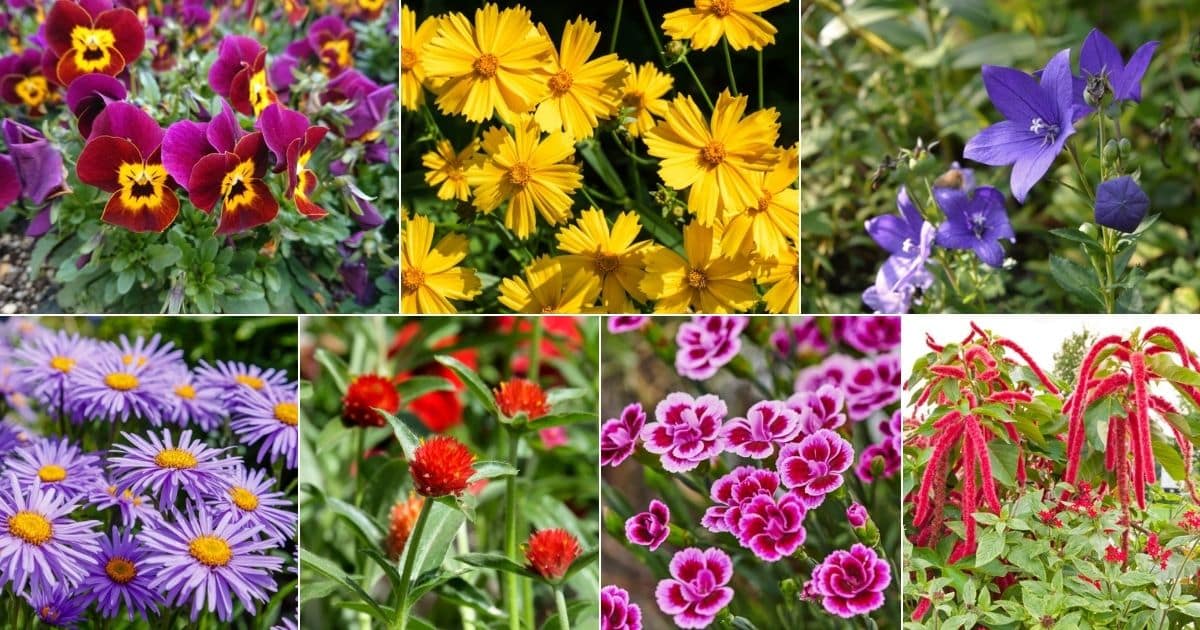
In this article, we’ll cover some of the best flowers to try growing in your autumn garden. Our choices include both long-lasting perennials and colorful annuals, with plants that are perfect for both in-ground gardens and container planters too.
So if you’re looking for ways to keep your garden looking gorgeous through fall, we’ve got some hardy plants and fall favorites just for you!
Jump to:
- Fall perennial flowers
- 1. Coneflower (Echinacea)
- 2. Rudbeckia (Black-eyed Susan)
- 3. Salvia
- 4. Goldenrod
- 5. Asters
- 6. Russian sage
- 7. Joe Pye weed
- 8. Tall garden phlox
- 9. Coreopsis
- 10. Japanese anemone
- 11. Sedum (Stonecrop)
- 12. Monkshood
- 13. Yarrow
- 14. Autumn crocus
- 15. Balloon flower
- Fall annual flowers
- 16. Florist mums
- 17. Sunflowers
- 18. Love lies bleeding
- 19. Celosia
- 20. Cosmos
- 21. Canna lily
- 22. Gomphrena
- 23. Verbena
- 24. Sweet alyssum
- 25. Petunias
- 26. Dianthus
- 27. Hardy fuchsia
- 28. Pansies
- 29. Nasturtium
- 30. Bachelor buttons
- The importance of autumn blooms
- Conclusion
Fall perennial flowers
Many gardeners prefer to plant only perennial plants, as they are frequently native to your region and better adapted to your particular location. Additionally, because perennials come back year after year, they tend to be less fuss than annuals and more budget-friendly too, as you won’t need to replace them year after year.
Many perennial options are easy to care for, requiring moderate amounts of sun and water and occasional fertilizer. Mulching your plants in autumn can help perennials better resist cold winters too.
While there are more fall-blooming perennials available, we’ve selected some of our absolute favorites. These plants are generally low maintenance, pollinator-friendly and offer plenty of gorgeous autumn blooms for your garden!
1. Coneflower (Echinacea)
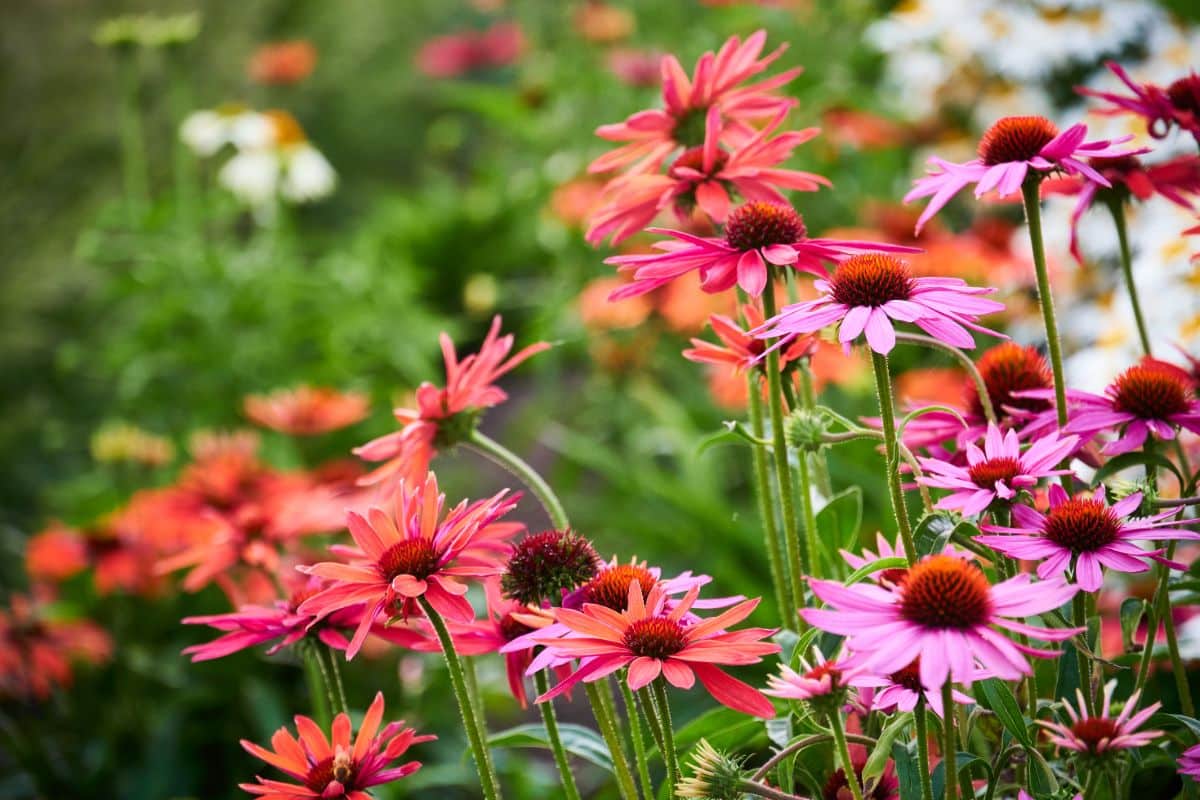
| Plant name: | Coneflower |
| Annual or perennial? | Perennial |
| Growing zone: | Zones 3 to 9 |
| Watering requirements: | Low |
| Lighting: | Full sun |
Coneflowers are incredibly resilient plants that can tolerate a range of conditions, including some drought. That makes them a wonderful choice for fall beds, especially in areas with dry autumns.
Growing up to 4’ tall, coneflowers make an excellent background plant for in-ground beds but they can thrill in container gardens as well. While they are most commonly found in purple, coneflowers can come in other colors too, including pink, orange and red. And, for bonus points, pollinators love them!
2. Rudbeckia (Black-eyed Susan)
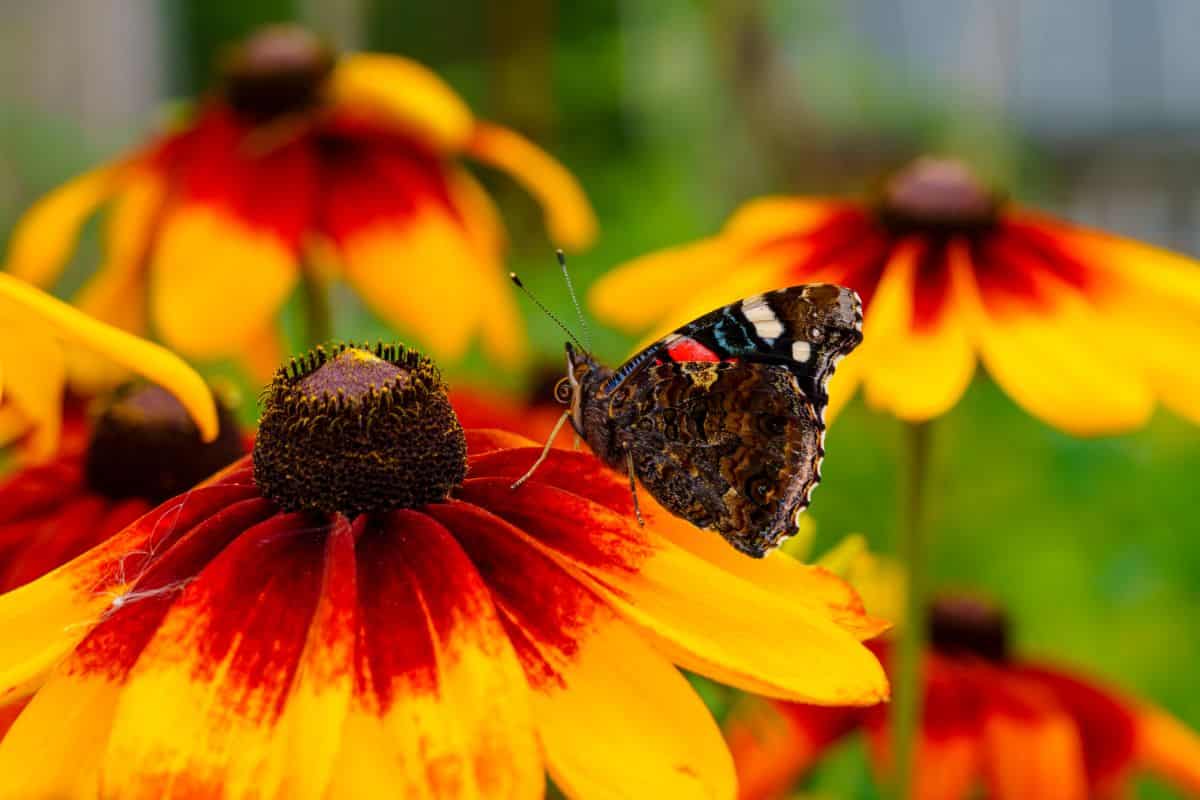
| Plant name: | Rudbeckia |
| Annual or perennial? | Perennial |
| Growing zone: | Zones 4 to 9 |
| Watering requirements: | Low |
| Lighting: | Full sun to part shade |
There are different varieties of rudbeckia, but black-eyed Susan are some of the most popular. These easy-going plants are known for their golden-yellow petals and dark, chocolatey brown centers.
Perfect in cut-flower gardens and arrangements, these flowers are frost tolerant and can keep blooming well into fall for lots of late season color. For additional variety, try out other types of rudbeckia with deep orange and mahogany flowers.
3. Salvia
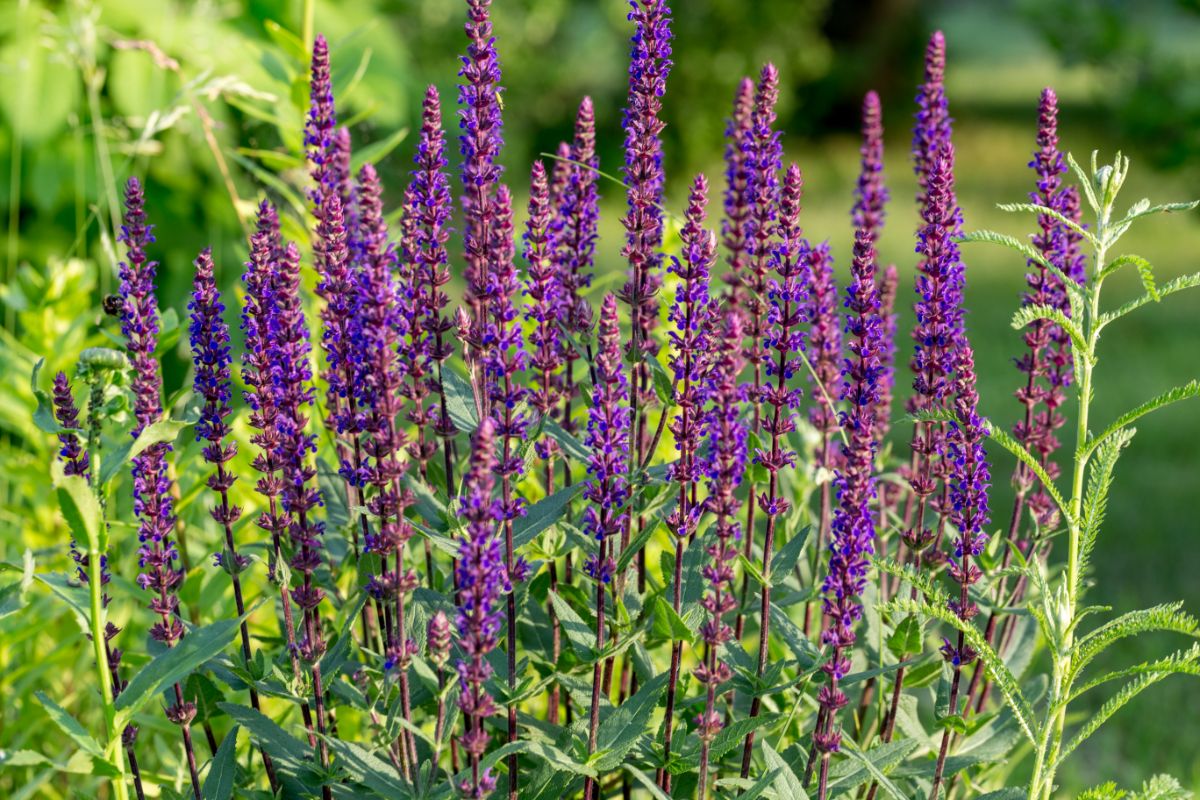
| Plant name: | Salvia |
| Annual or perennial? | Perennial, although annual salvias exist too |
| Growing zone: | Zones 4 to 10, depending on variety |
| Watering requirements: | Low |
| Lighting: | Full sun, although some varieties will tolerate part shade |
As autumn gardens are commonly bursting with warm orange and red colors, adding a pop of contrasting purple is a surefire way to make your garden design come to life. Salvia, known for their rich, purple hues, is a wonderful plant for the job.
Very popular with bees and other pollinators, salvias are also important autumnal snacks that help sustain beneficial insects during the long winter months. But beyond that, they are simply a delight in the garden, where their tall, spire-like flowers add structure and texture to landscapes.
4. Goldenrod
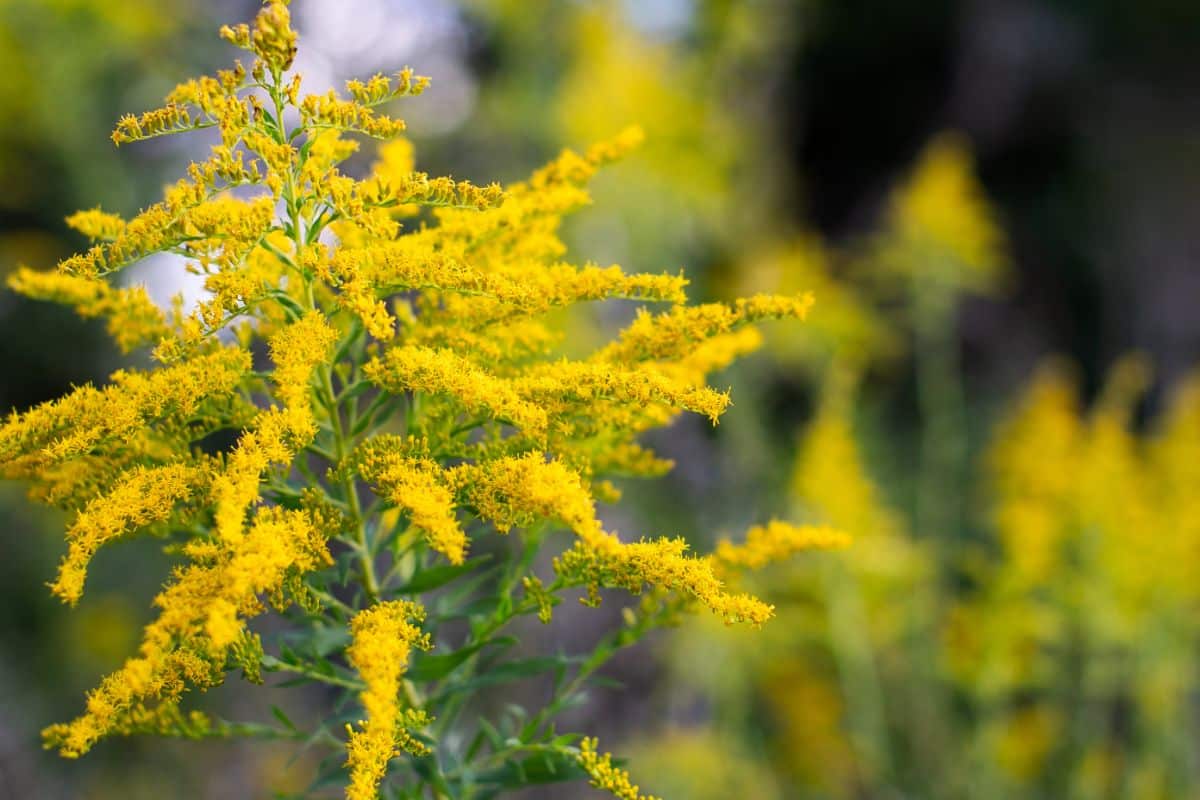
| Plant name: | Goldenrod |
| Annual or perennial? | Perennial |
| Growing zone: | Zones 4 to 9 |
| Watering requirements: | Low |
| Lighting: | Full sun |
A native wildflower with vibrant yellow flowers, goldenrod is a happy plant that looks right at home in any autumn garden. Goldenrod is often confused with ragweed, a similar looking plant; however, unlike ragweed, goldenrod doesn’t usually cause seasonal allergies.
While goldenrod can look exceptional in cut flower arrangements, for a unique twist, you can also try dyeing fabric with it to create a bright yellow color. For best results, choose natural fabrics, like wool or cotton, and be sure to leave some goldenrod blooms when you harvest because they are an important pollinator food.
5. Asters
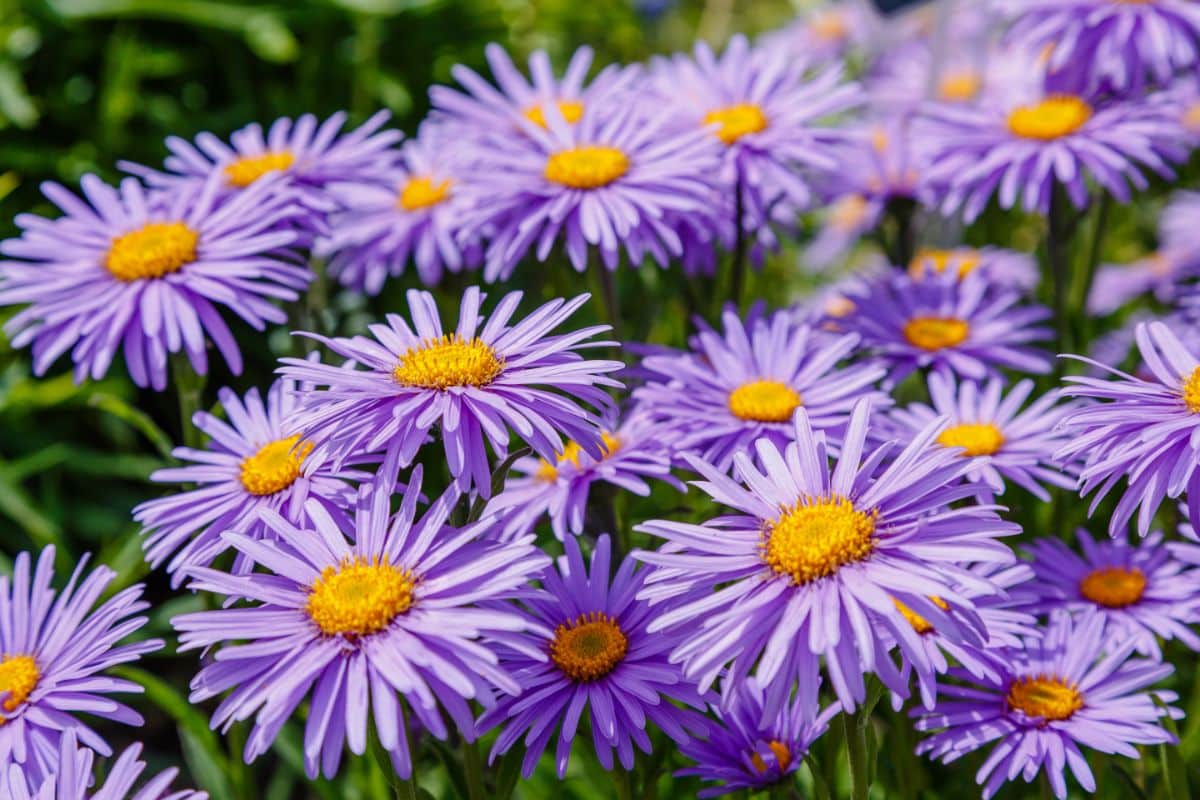
| Plant name: | Asters |
| Annual or perennial? | Perennial |
| Growing zone: | Zones 3 to 8 |
| Watering requirements: | Low to moderate |
| Lighting: | Full sun |
Some asters are native wildflowers and will come up on their own, without you needing to plant them. For even more color, you may want to seek out more showy varieties too, like ‘Monte Casino’ and ‘Fellowship.’
Great for autumn gardens, asters are frost tolerant and you can still find them blooming well into fall. And, if you love asters, there’s even more good news: they self-seed readily!
6. Russian sage
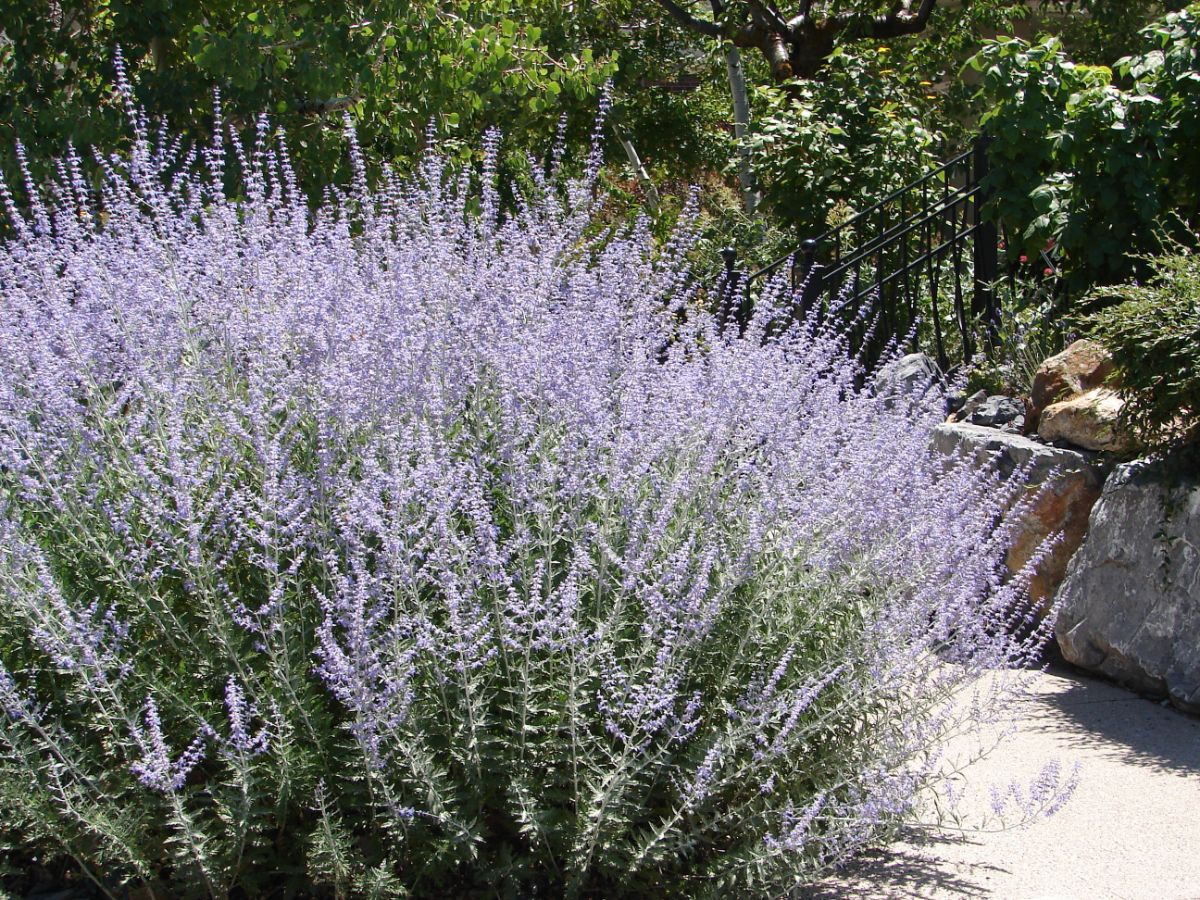
| Plant name: | Russian sage |
| Annual or perennial? | Perennial |
| Growing zone: | Zones 4 to 9 |
| Watering requirements: | Low |
| Lighting: | Full sun |
Another important pollinator plant, Russian sage is known for its silver-gray foliage and sprays of pale purple flowers. When you brush against it, be prepared for an aromatic treat, as this plant has a wonderful fragrance with notes of sage and lavender.
Drought-tolerant once established, Russian sage can grow up to 3’ high. Relatively easy to care for, just make sure your plants receive lots of full sun and plant them in well-draining soil and you should be good to go.
7. Joe Pye weed
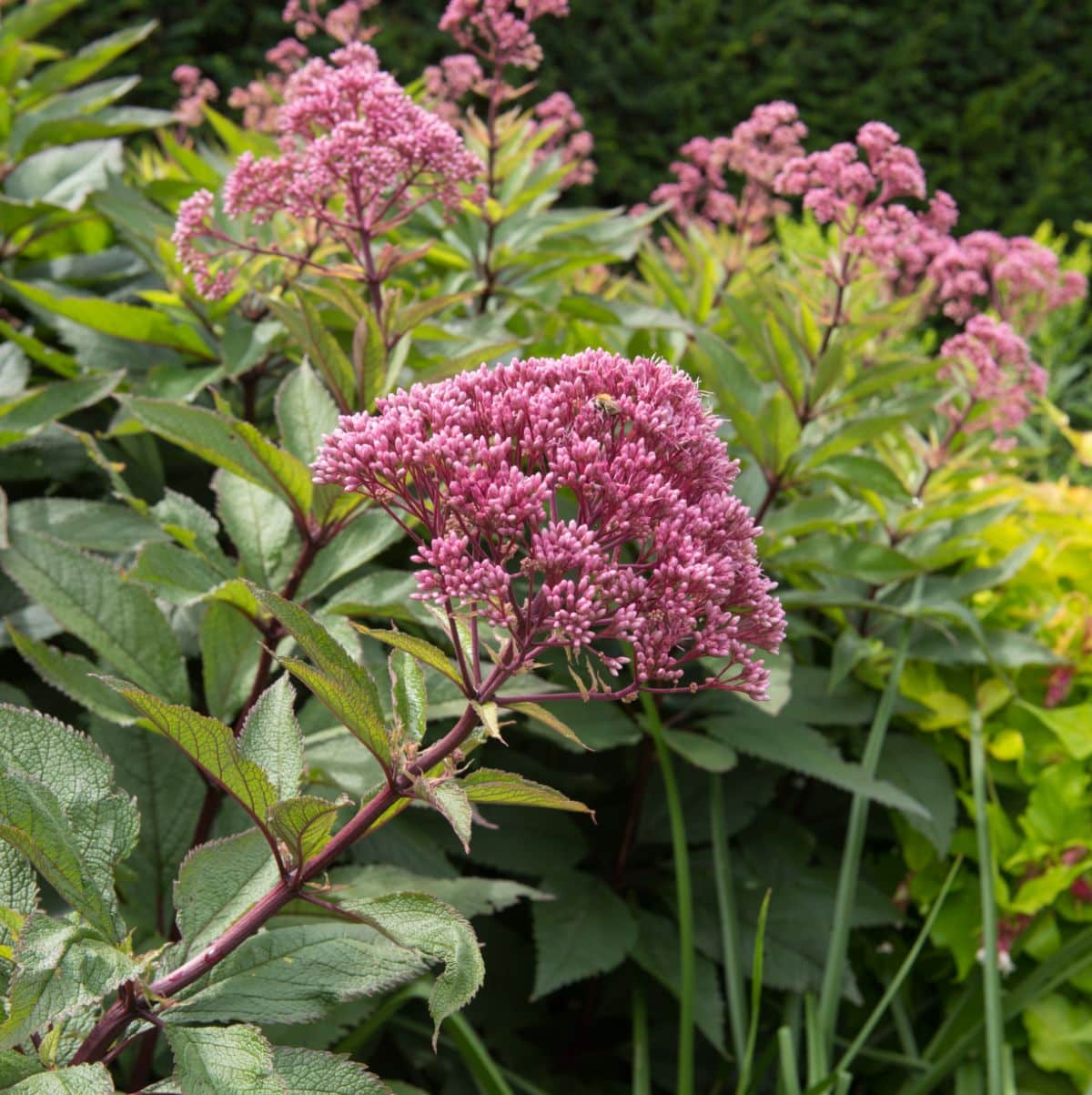
| Plant name: | Joe Pye weed |
| Annual or perennial? | Perennial |
| Growing zone: | Zones 4 to 8 |
| Watering requirements: | High |
| Lighting: | Full sun to part shade |
Native to North America, Joe Pye weed is a common wildflower in some areas, but it makes an interesting addition to garden beds too. Growing up to 8’ tall, just be sure to plant these plants in the back of your garden beds so they don’t shade out lower growing specimens.
Frequently found in moist, wetland areas, Joe Pye weed needs more moisture than some other autumnal flowers, but it still is quite easy to grow. And if you needed more reasons to try out this plant, it has a wonderful vanilla-like fragrance too.
8. Tall garden phlox
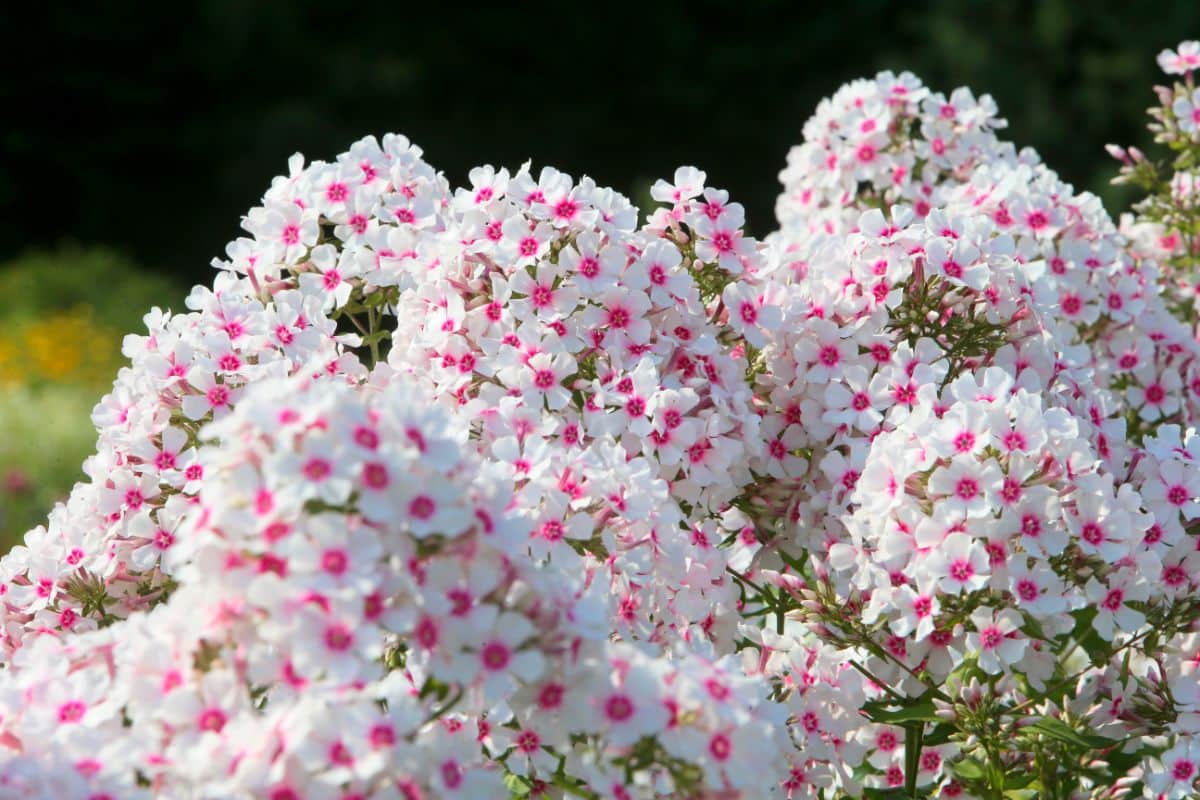
| Plant name: | Garden phlox |
| Annual or perennial? | Perennial |
| Growing zone: | Zones 4 to 8 |
| Watering requirements: | Moderate |
| Lighting: | Full sun to part shade |
Different phlox cultivars bloom at different times of the year, but most start flowering from mid-summer to late-fall. Although they are related, tall garden phlox should not be confused with the lower growing, creeping phlox, which is a springtime bloomer.
Garden phlox flowers can be seen in white, pink, red or purple and they emit a sweet, floral fragrance which pollinators love. Another low maintenance plant, phlox should be divided every 2 to 4 years for best growth.
9. Coreopsis
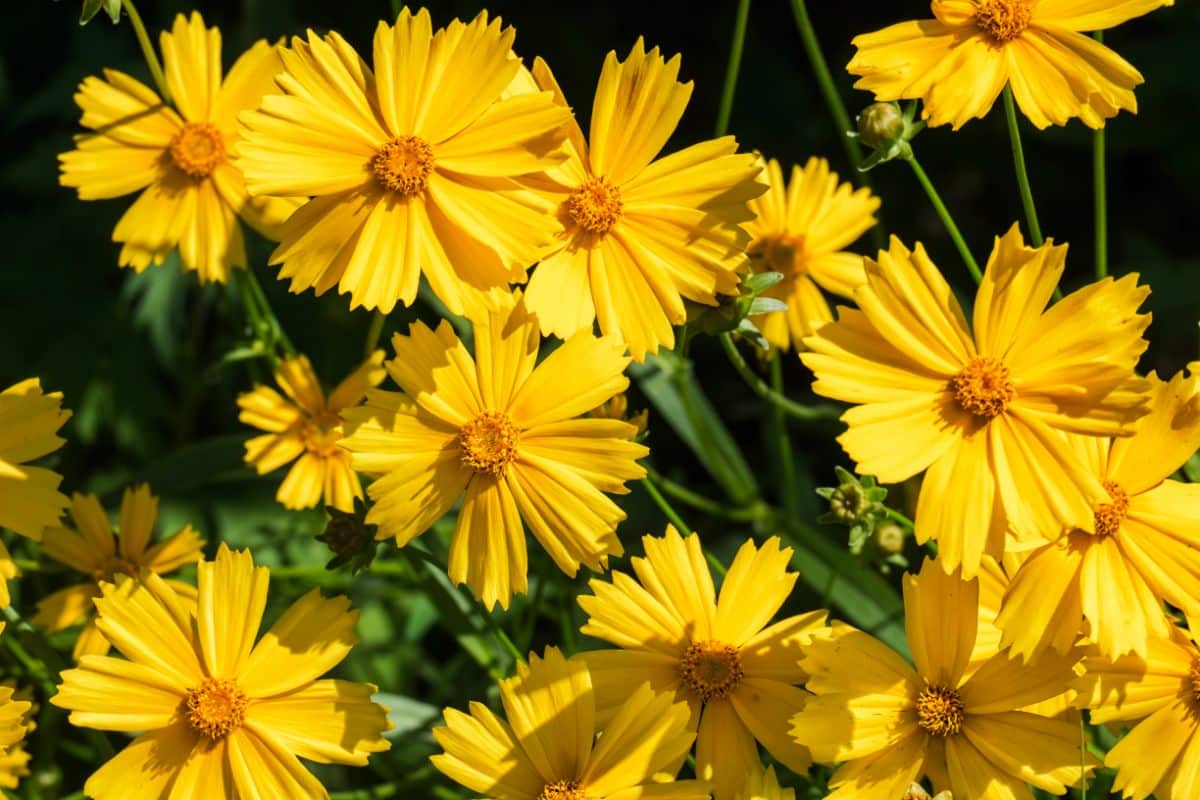
| Plant name: | Coreopsis |
| Annual or perennial? | Perennial |
| Growing zone: | Zones 4 to 9 |
| Watering requirements: | Moderate |
| Lighting: | Full sun |
Also known as “tickseed” for their unusually shaped seeds, coreopsis is an easy-care perennial plant with bright, daisy-like blooms. Drought-tolerant, coreopsis is a no fuss-plant, but it can benefit from occasional deadheading to encourage more flower production.
Sun-loving coreopsis flowers most commonly come in yellow, but they can be pink, white, orange purple or bi-colored too. Plants can be divided every 3 to 4 years, or allow them to spread on their own via seeds or underground rhizomes.
10. Japanese anemone
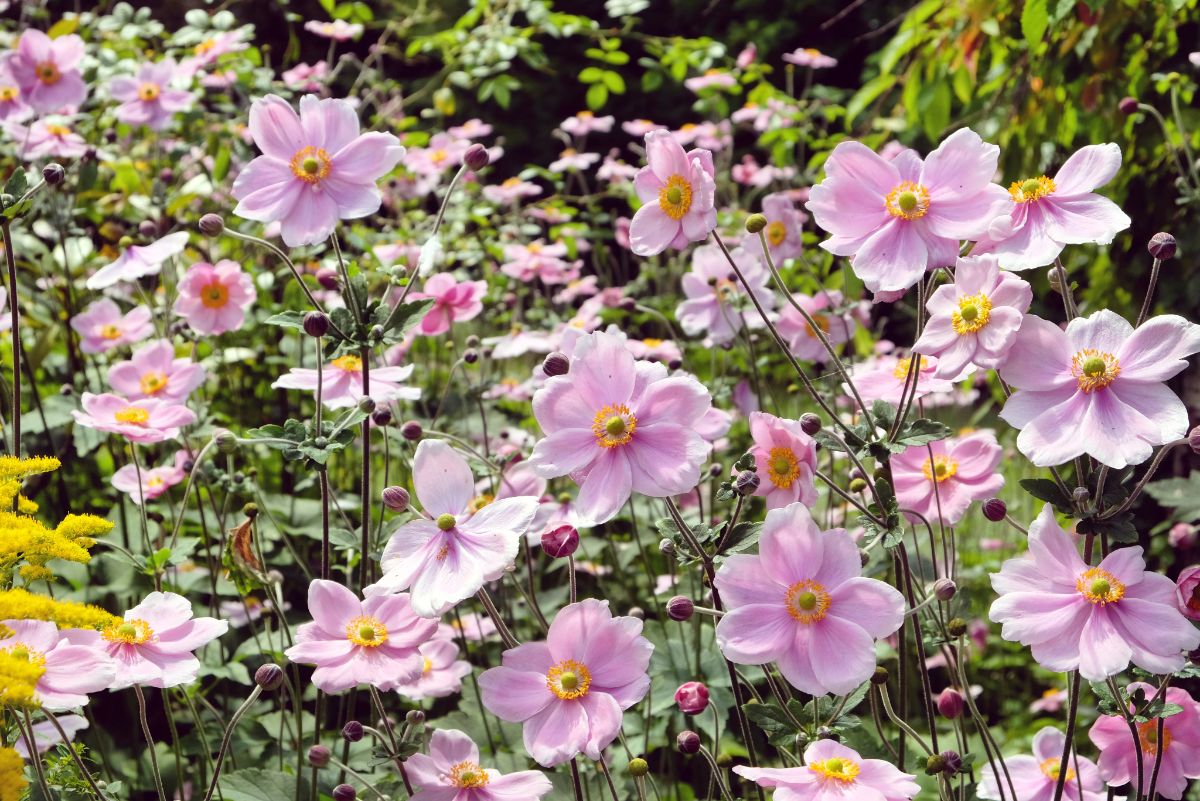
| Plant name: | Japanese anemone |
| Annual or perennial? | Perennial |
| Growing zone: | Zones 4 to 8 |
| Watering requirements: | Moderate to high |
| Lighting: | Part shade |
Blooming from mid-summer well into September and October, Japanese anemone is a less common sight in fall gardens, but no less delightful. Flowers range from white to dark pink or purple and are perched atop long stems, which gives this plant a delicate, airy effect.
When growing Japanese anemone, keep in mind that they prefer consistently moist soil and don’t do well when they dry out. To maintain happy plants, remember to water your anemones regularly and consider adding a layer of mulch to trap in moisture.
11. Sedum (Stonecrop)
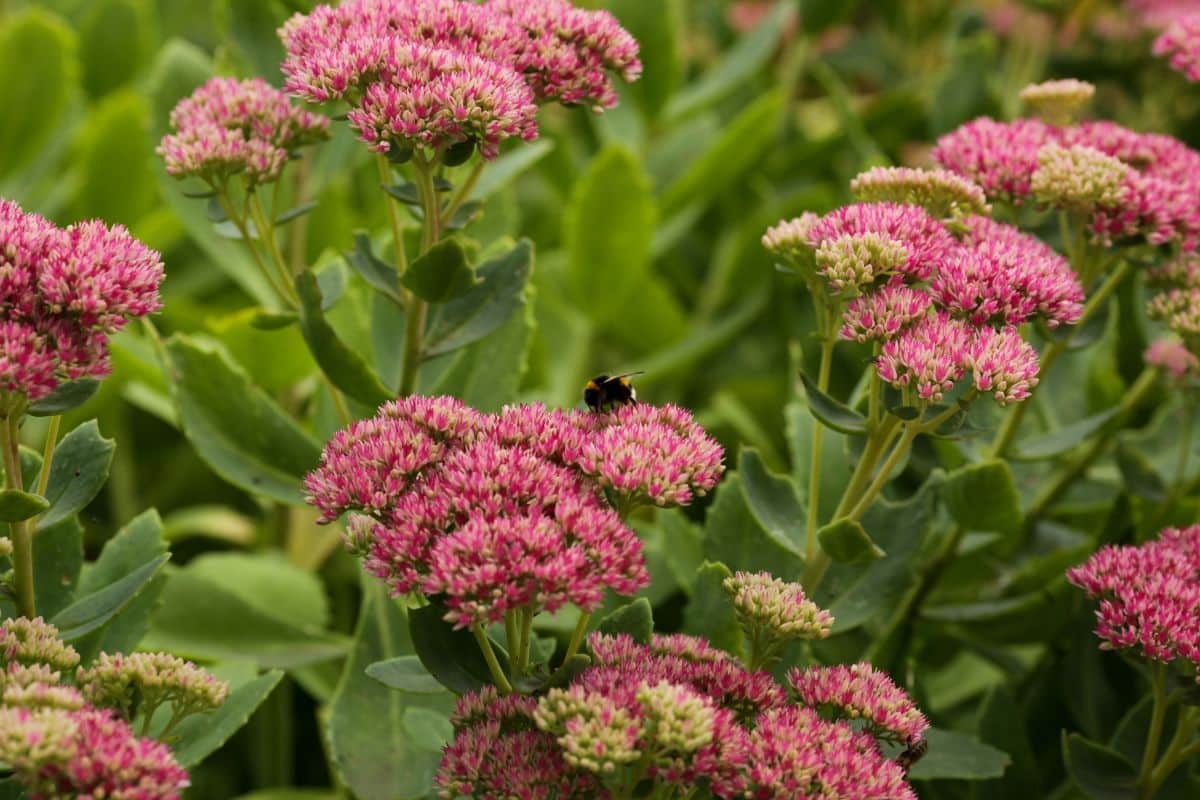
| Plant name: | Sedum |
| Annual or perennial? | Perennial |
| Growing zone: | Zones 3 to 11 |
| Watering requirements: | Low |
| Lighting: | Full sun |
It’s no wonder why sedum are a common plant for fall gardens. They are a flowering succulent, which means they store water in their fleshy leaves. As a result, they are very drought tolerant and low maintenance plants to keep.
Sedum bloom from July through late fall, with flower colors available in pink, purple, blue and chartreuse. After they are done blooming, sedum flowers easily dry out on their stems and some gardeners opt to leave spent blooms in place all winter long for extra texture in winter gardens.
12. Monkshood
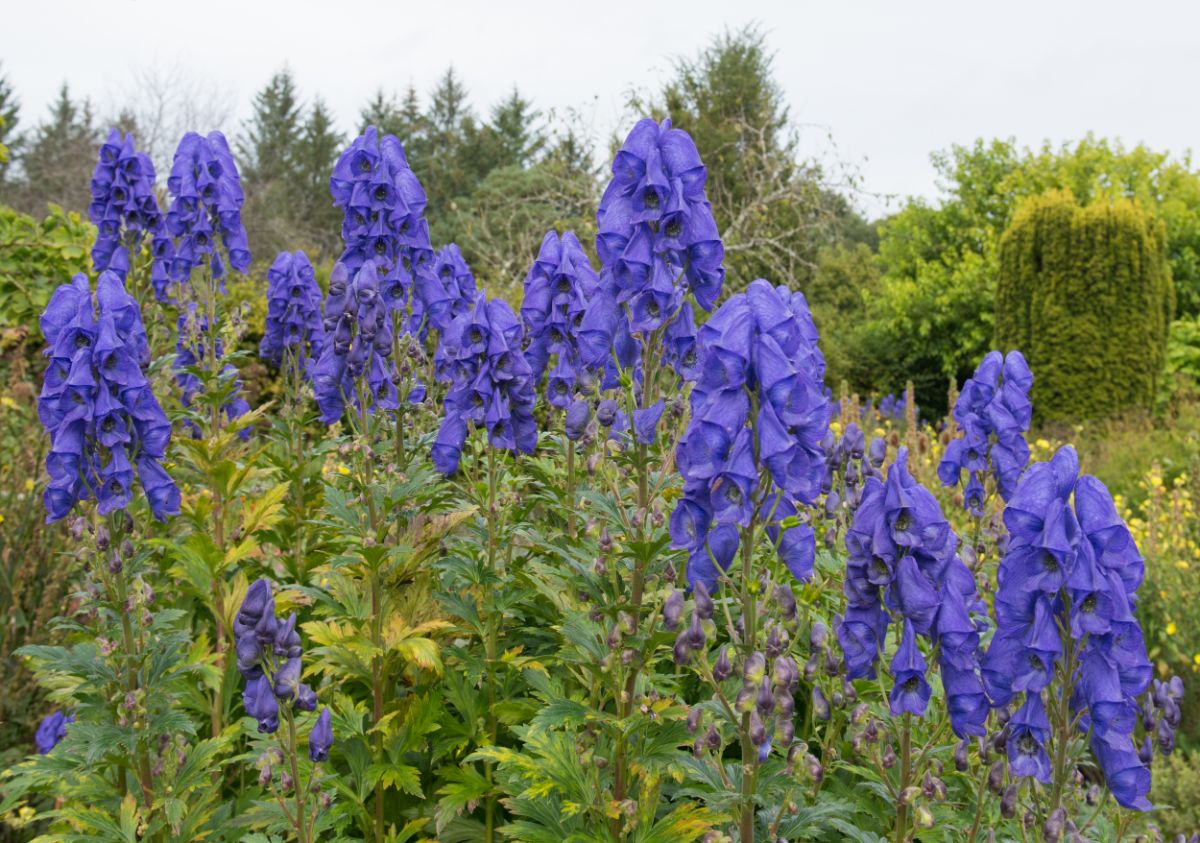
| Plant name: | Monkshood |
| Annual or perennial? | Perennial |
| Growing zone: | Zones 3 to 7 |
| Watering requirements: | Moderate |
| Lighting: | Full sun to part shade |
Monkshood is a less common perennial flower that is found throughout the Northern hemisphere, but is native to Europe and Asia. Flowers most commonly appear in blueish-purple, but they can appear in pink, white or yellow too.
Named for its unusually shaped flowers, which are said to resemble the draped fabric of a monk’s hood, this flower is quite poisonous, so care should be taken with it. When handling this plant, gloves should be worn at all times and it should not be planted in areas where small children or pets are present.
13. Yarrow
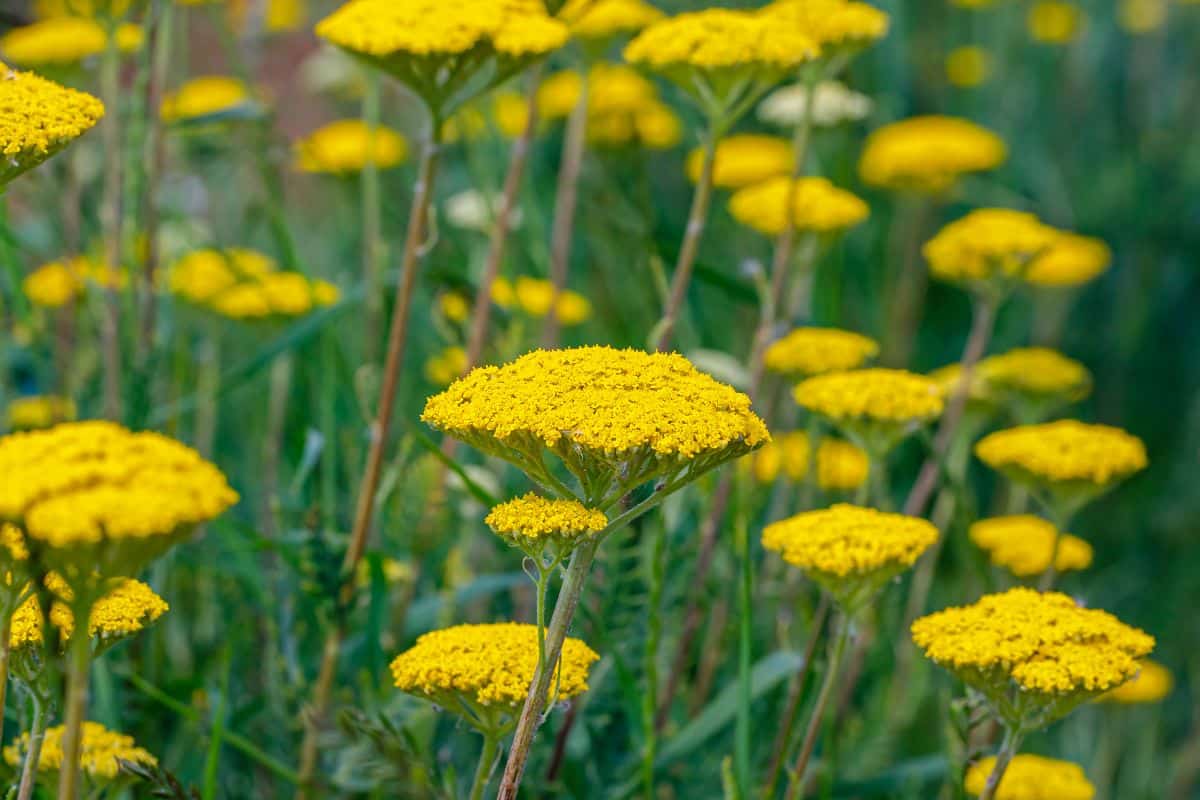
| Plant name: | Yarrow |
| Annual or perennial? | Perennial |
| Growing zone: | Zones 3 to 7 |
| Watering requirements: | Low |
| Lighting: | Full sun |
Yarrow has an exceptionally long blooming time, with flowers appearing from spring well into fall. Flowers most commonly come in white, but many plant nurseries have yellow and pink varieties too.
Yarrow is a very important plant for pollinators, especially butterflies. Yarrow’s large, flat blooms make these flowers ideal “landing pads” for visiting pollinators who come to feed from these nectar- and pollen-rich plants.
For even more value, try keeping yarrow in cut flower beds and drying flowers too for preserved displays.
14. Autumn crocus

| Plant name: | Autumn crocus |
| Annual or perennial? | Perennial |
| Growing zone: | Zones 5 to 9 |
| Watering requirements: | Moderate |
| Lighting: | Full sun |
Autumn crocus may look a lot like the crocuses that bloom in springtime, but they come from an entirely different plant family: Colchicaceae. Autumn crocus are best planted in mid- to late summer for autumn blooms.
Flowers are small and cup-shaped and come in pinkish-purple or white. Autumn crocus should not be confused with saffron crocus (Crocus sativus, also sometimes known as “autumn crocus” to make things difficult) as saffron crocus is edible but ornamental autumn crocus is not.
15. Balloon flower
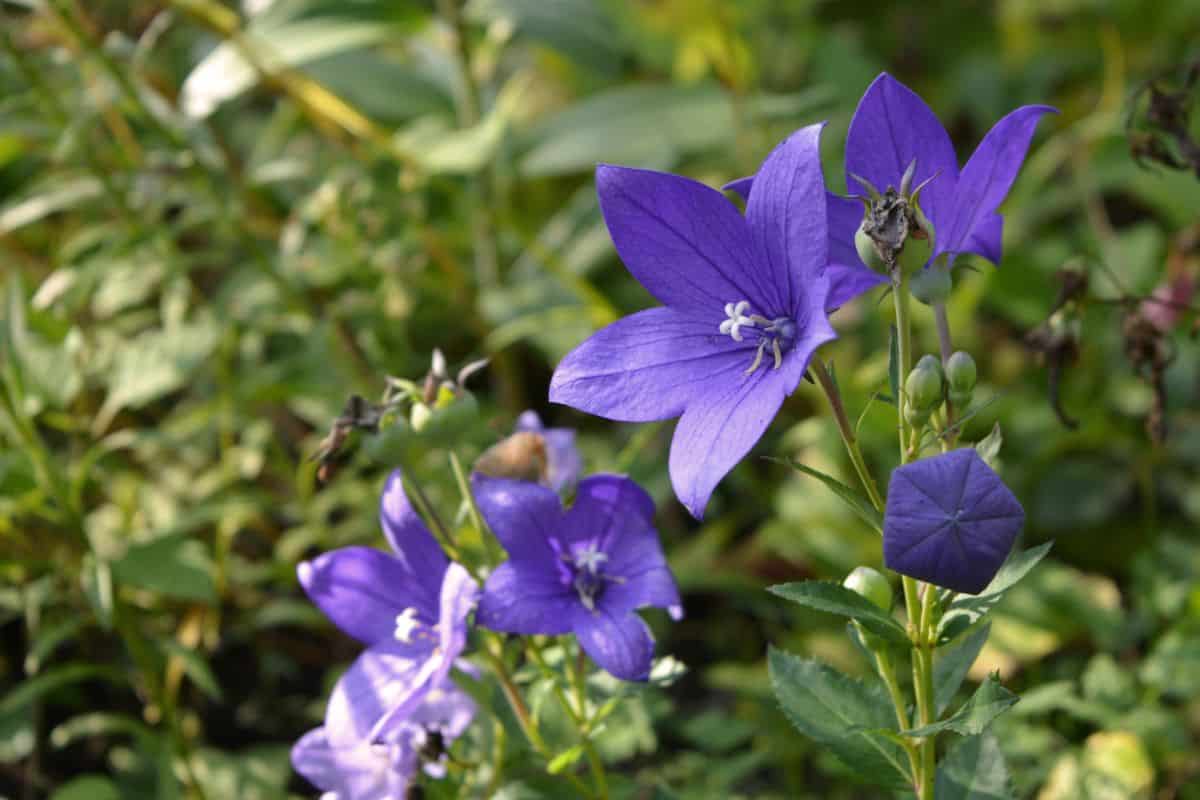
| Plant name: | Balloon flower |
| Annual or perennial? | Perennial |
| Growing zone: | Zones 3 to 8 |
| Watering requirements: | Moderate |
| Lighting: | Full sun |
As the name suggests, balloon flower has large bulbous or bell-shaped flowers that are round and balloon-like before fully opening. Blooms come in purple, pink or white and plants are very easy to care for.
Native to East Asia, balloon flowers are sometimes also called platycodon and Chinese bellflowers. While balloon flowers grow in clumps, they don’t divide well. Instead, for more plants, allow these prolific self-seeders to spread on their own or propagate plants via stem cuttings.
Fall annual flowers
Annuals are plants that don’t come back year after year, but what they lack in longevity, they more than make up for with their big blooms and colorful petals.
Some of the annuals we’ve chosen are quite frost-hardy, so they should last you well into autumn. Other choices are more sensitive to cold, but you can extend your growing season by carefully covering these tender plants with frost blankets, cloches or a lightweight bedsheet.
16. Florist mums
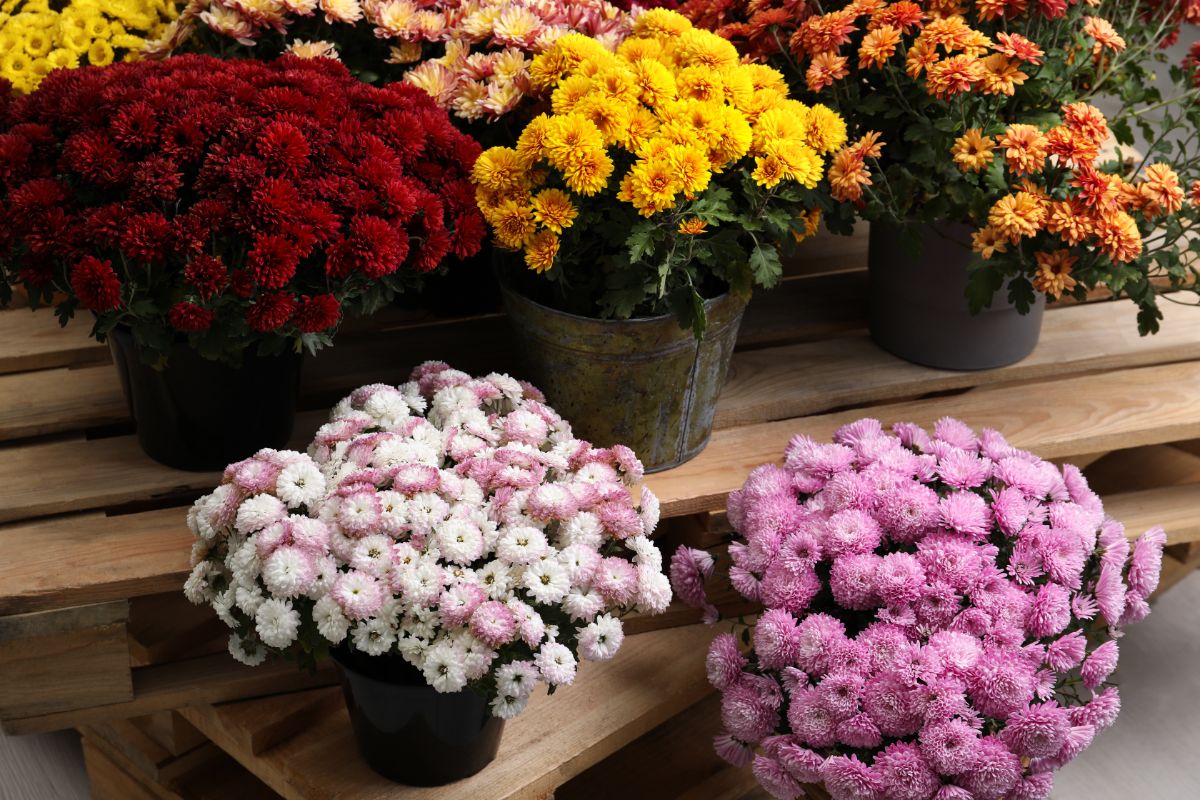
| Plant name: | Florist mums |
| Annual or perennial? | Annuals, in most areas |
| Growing zone: | Perennials in zones 7 to 9 |
| Watering requirements: | Moderate to high |
| Lighting: | Full sun |
Mums, also known as chrysanthemums, are a classic in the autumn garden. They work well for in-ground beds, but really shine in container gardens, where their vibrant yellow, purple or orange flowers can’t help but draw the eye.
Native to Asia, mums can grow as perennials in zones 7 to 9, but are most commonly kept as annuals in most areas. Not frost hardy, extend your mums’ bloom time by placing them in a sheltered location and covering them with a light fabric sheet when frost is on the forecast.
17. Sunflowers
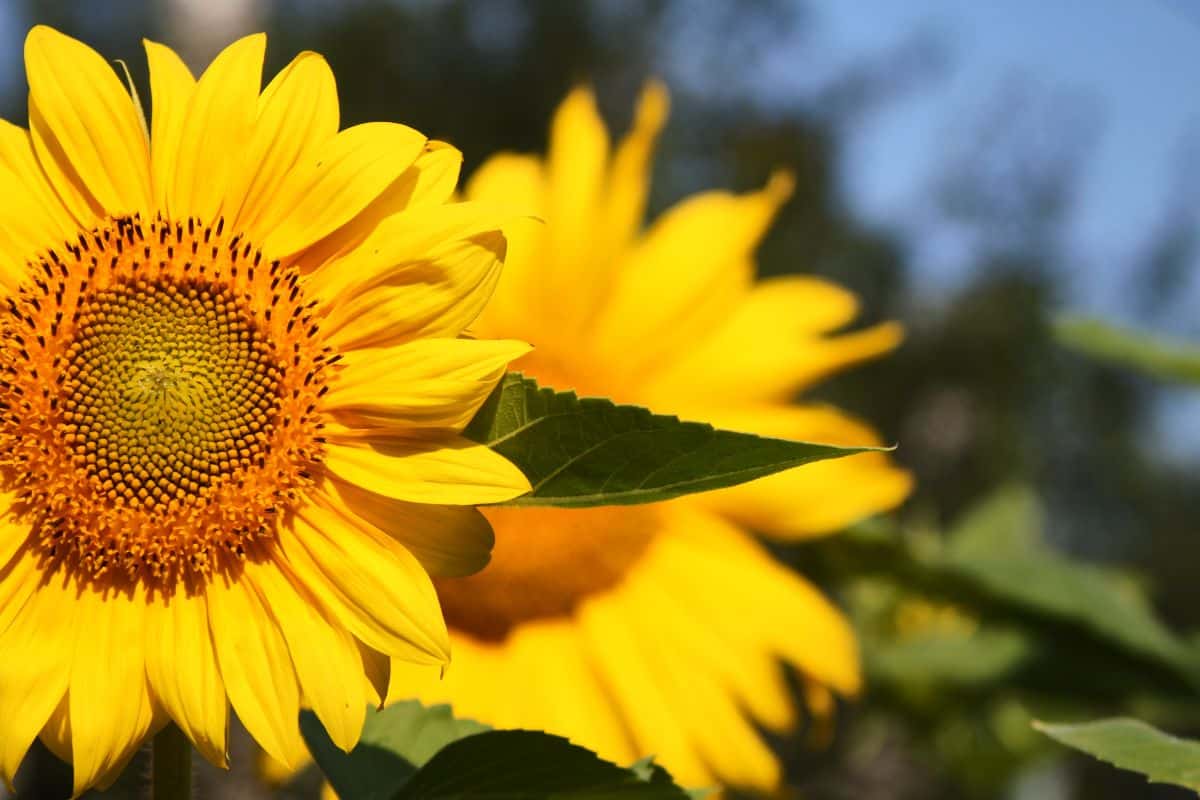
| Plant name: | Sunflowers |
| Annual or perennial? | Annual |
| Growing zone: | Zones 4 to 9 |
| Watering requirements: | Moderate |
| Lighting: | Full sun |
Sunflowers are best planted from seed and are usually directly sown in the garden after the danger of frost has passed in late spring. This is because sunflowers don’t transplant well but are, otherwise, quite low maintenance plants.
Sunflowers begin blooming in summer but can continue to flower well into autumn too. For more variety, look for sunflowers in unusual colors, like white or deep mahogany, and try out some dwarf varieties in container planting arrangements.
18. Love lies bleeding

| Plant name: | Love lies bleeding |
| Annual or perennial? | Annual |
| Growing zone: | Zones 2 to 11 |
| Watering requirements: | Low |
| Lighting: | Full sun to part shade |
A variety of amaranth, love lies bleeding is known for its unusual, trailing, bright-pink flowers. A real showstopper, this stunning plant is a perfect choice for anyone looking for something different.
Flowers appear in July and last through frost, eventually maturing into seeds which birds love. While this is a gorgeous ornamental, it is also an ideal choice for backyard gardens as it will provide wildlife with a reliable food source so they can survive hibernation or migration.
19. Celosia
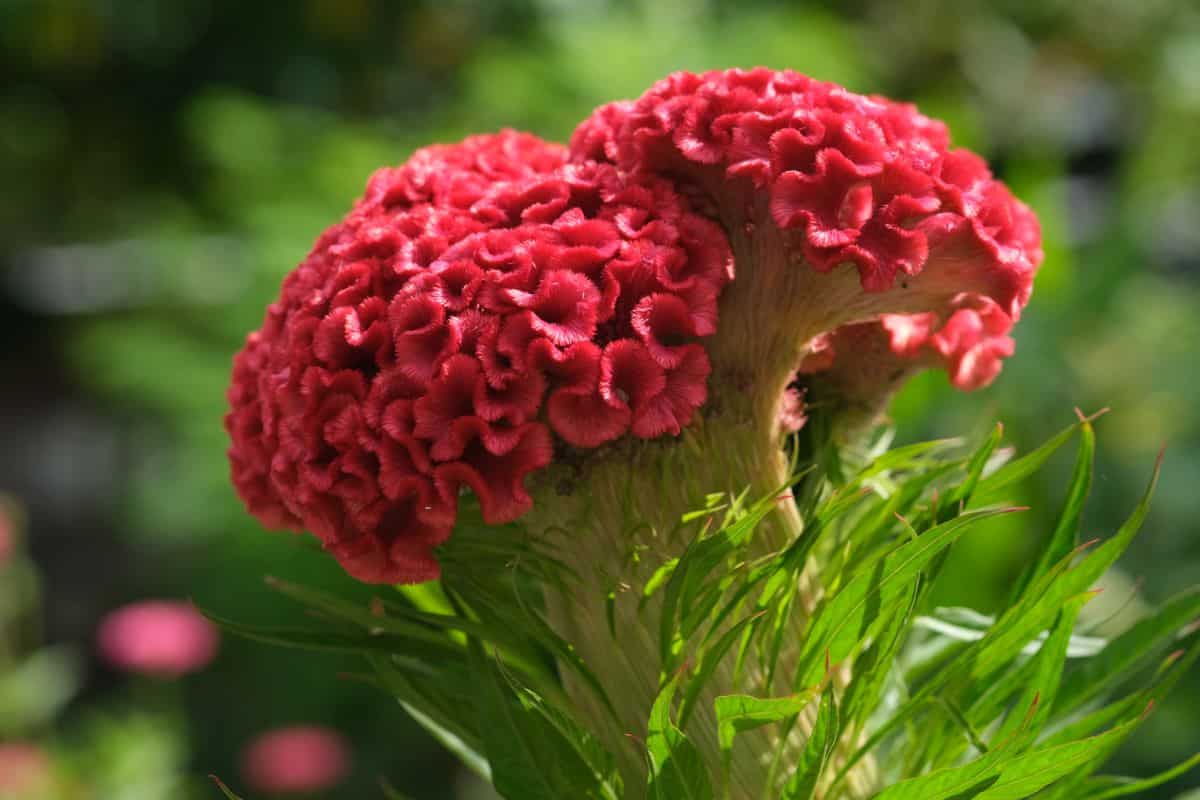
| Plant name: | Celosia |
| Annual or perennial? | Annuals, in most areas |
| Growing zone: | Perennials in zones 10 to 12 |
| Watering requirements: | High |
| Lighting: | Full sun |
If you like big, bold colors and interesting flower shapes, you can’t go wrong with celosia. Some celosia varieties have very unique flower structures, more closely resembling marine corals than garden flowers.
Also known as cockscomb, celosia come in yellow, orange, pink and red for lots of color. Plants can easily be grown from seed or nursery starts, with popular varieties being ‘crested’ celosia, ‘wheat’ celosia and ‘plume’ celosia.
20. Cosmos
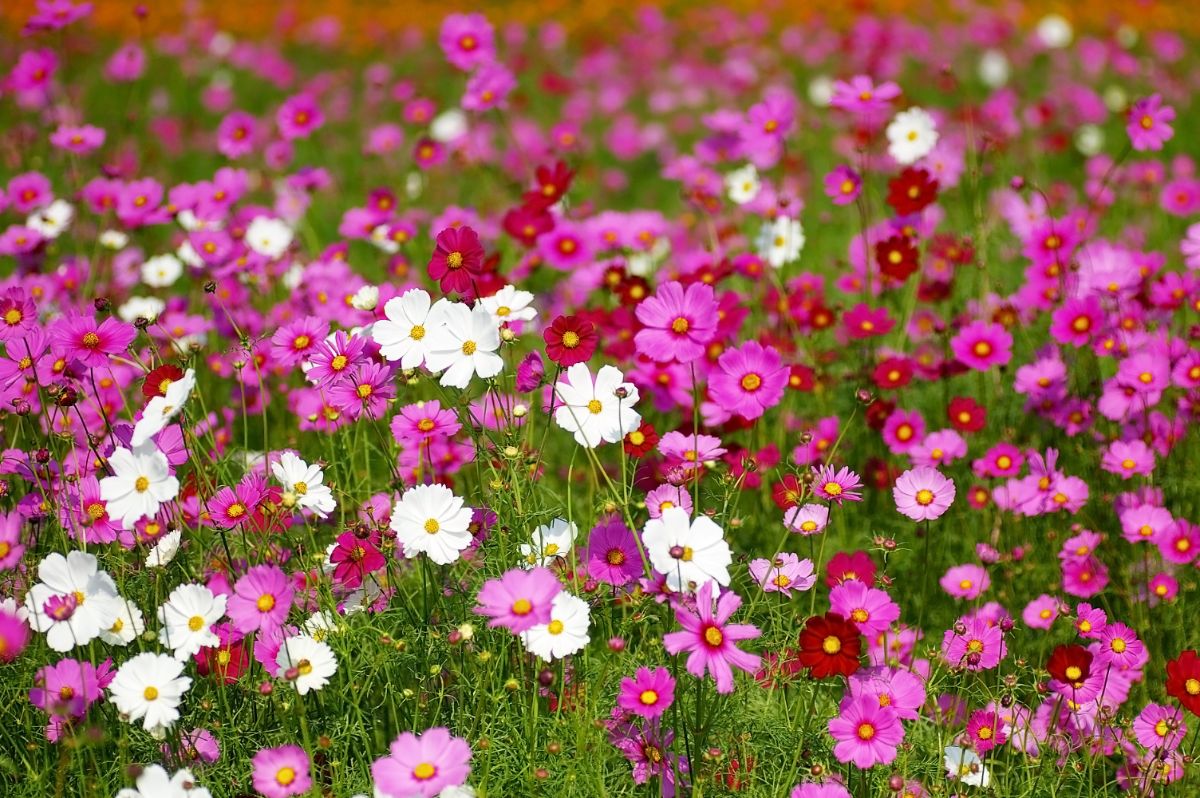
| Plant name: | Cosmos |
| Annual or perennial? | Annual |
| Growing zone: | Zones 2 to 11 |
| Watering requirements: | Low |
| Lighting: | Full sun |
Cosmos have a very delicate, airy feel to them with flowers coming in dark pink to white. Pollinator favorites, cosmos are simple to grow from seed and can easily self-sow if you allow them to.
An easy to care for plant, cosmos look perfect in container gardens and in-ground beds too. And, if you love making homegrown bouquets, these are some of the best plants to grow for autumn arrangements. As a cut-and-come-again flower, the more you harvest cosmos, the more flowers the plants will produce.
21. Canna lily
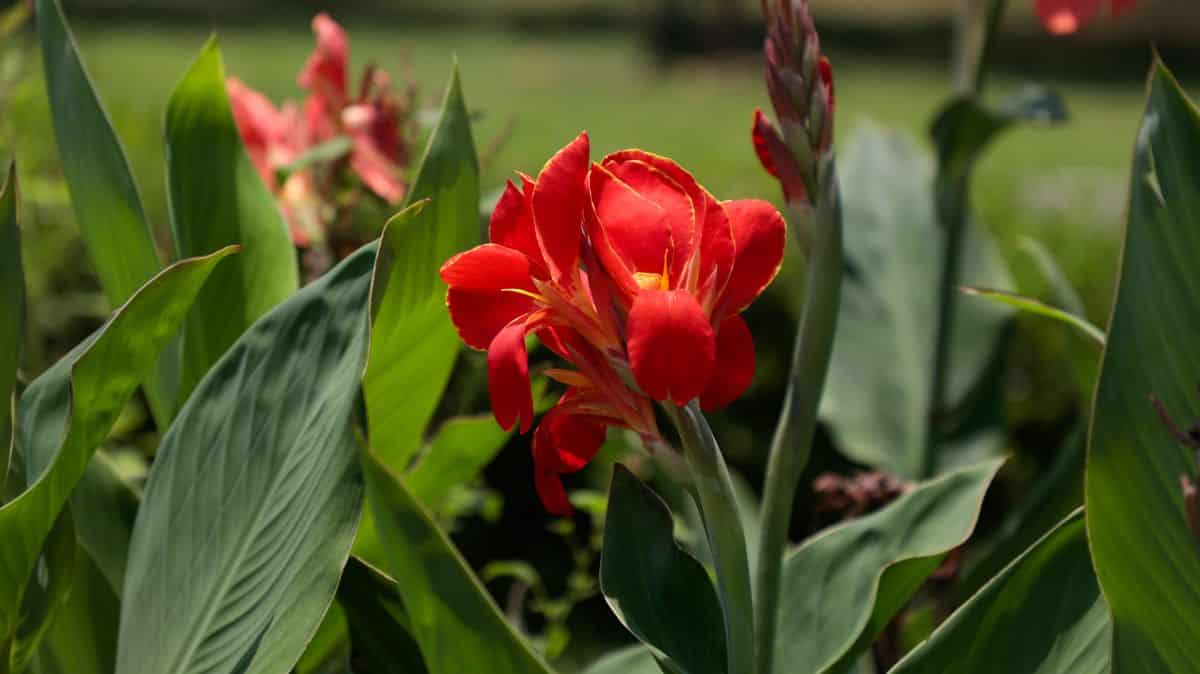
| Plant name: | Canna lily |
| Annual or perennial? | Annual, in most areas |
| Growing zone: | Perennials in zones 8 to 11 |
| Watering requirements: | High |
| Lighting: | Full sun |
Canna lilies are native to the tropics of North and South America, where they can be grown as perennials. However, they are only hardy to zone 8, so most gardeners grow them as annuals instead.
If you live in a cooler region but you’d like to keep your canna lilies coming back, try digging their rhizomes up just after frost kills off the plant’s foliage. Rhizomes can be overwintered indoors in a cool, dark and dry location until spring.
With flowers in yellow, orange and red, canna lilies are some of the most colorful flowers on this list, so if you’re not shy about color, they are a great choice. Try them out in container gardens and potted arrangements for extra flare.
22. Gomphrena

| Plant name: | Gomphrena |
| Annual or perennial? | Annual, in most areas |
| Growing zone: | Perennials in zones 9 to 11 |
| Watering requirements: | Low |
| Lighting: | Full sun |
Another member of the amaranth family, gomphrena’s globular flowers look a bit like some types of clover, but with a twist. These plants grow up to 2’ tall and offer lots of autumn color, with blooms appearing in pink, white, orange and red.
Blooming from summer to frost, gomphrena loves well-draining soil and lots of bright sun. If you have difficulty finding them at your local nursery, you can also grow these plants from seeds. Just be sure to plan ahead and start seeds indoors in early spring.
23. Verbena
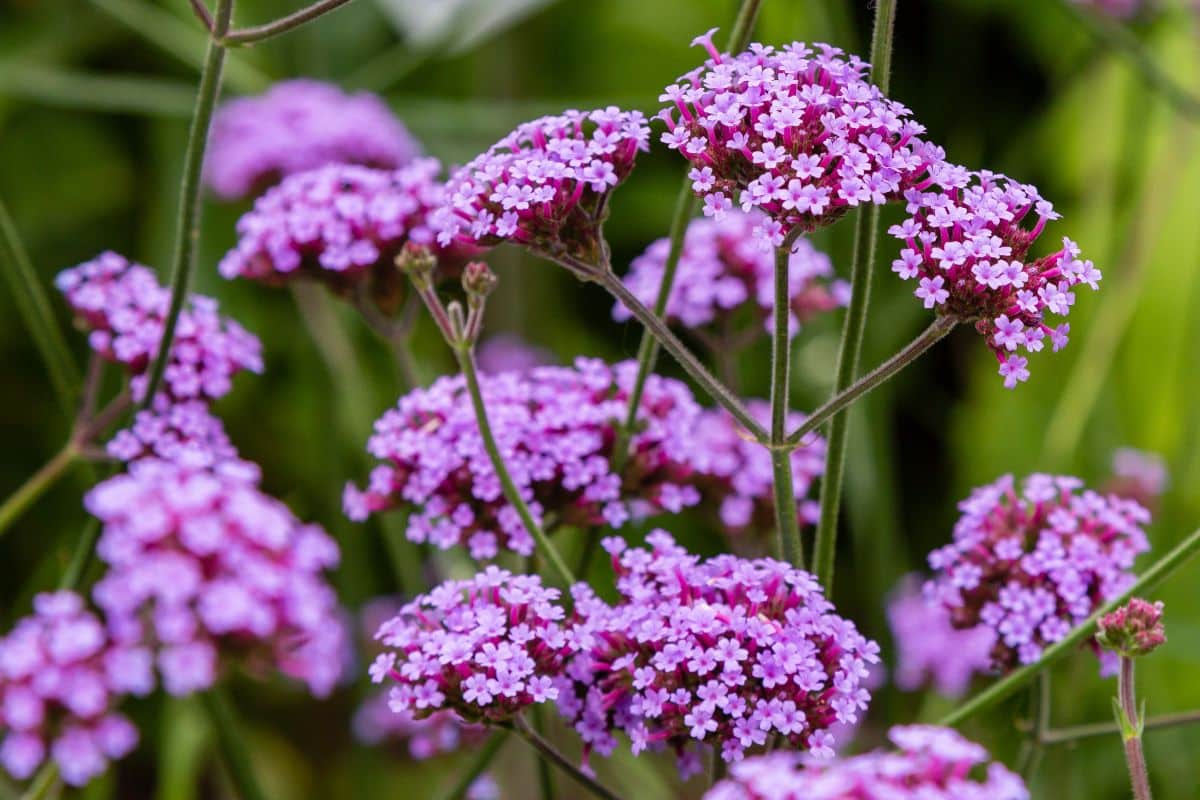
| Plant name: | Verbena |
| Annual or perennial? | Annual, in most areas |
| Growing zone: | Perennials in zones 8 to 11 |
| Watering requirements: | Low to moderate |
| Lighting: | Full sun |
Butterflies and bees love verbena, but we love them too thanks to their clusters of pretty purple flowers. And, while purple flowers are the most common, they can come in other colors too, like pink, red and white.
Verbena blooms appear on the top of long stalks, giving the plants a light, airy feel. Blooming from late summer to early fall, verbena can grow as a perennial in warmer areas, but is most frequently kept as an annual.
24. Sweet alyssum
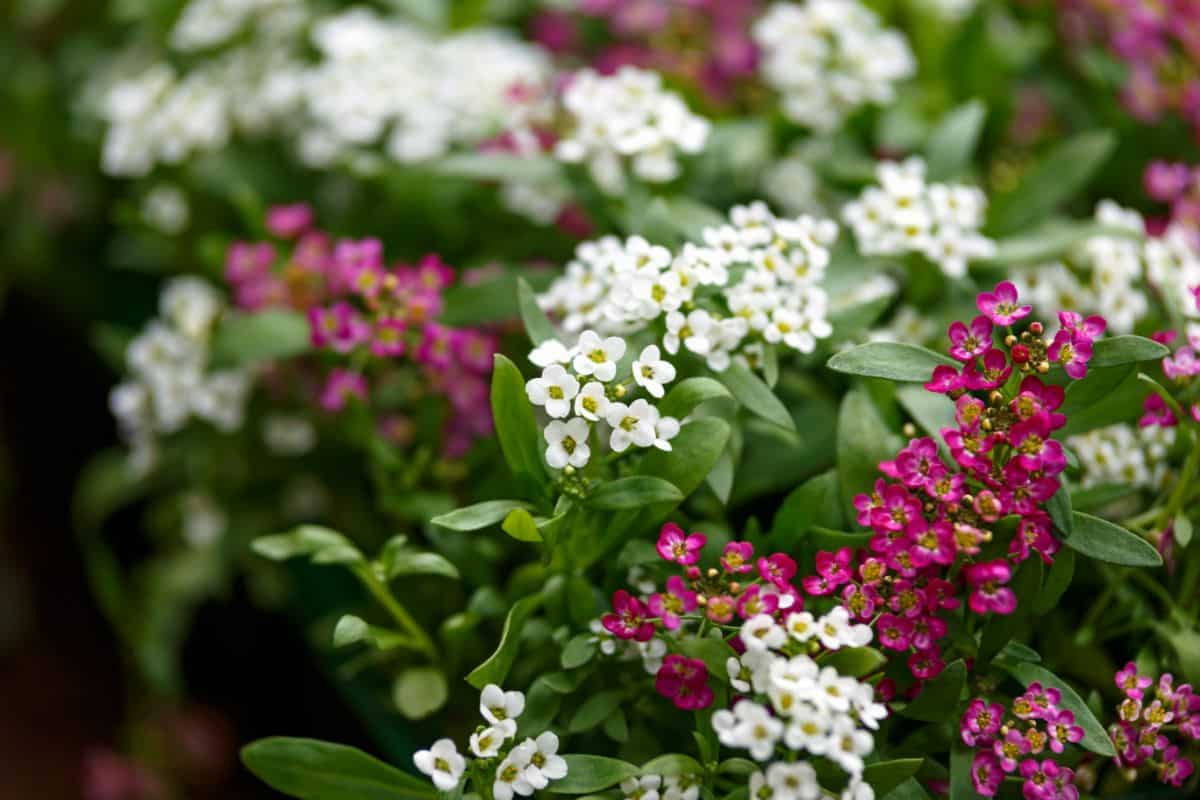
| Plant name: | Sweet alyssum |
| Annual or perennial? | Annual, in most areas |
| Growing zone: | Perennials in zones 9 to 11 |
| Watering requirements: | Moderate |
| Lighting: | Full sun to part shade |
Sweet alyssum has tiny purple and white flowers and a trailing growth habit that lends itself well to container gardens where it spills over planter edges for more visual interest. Alyssum can do well in garden beds too, but plant these low-growing beauties towards the front of your beds so they don’t get buried by taller specimens.
Sweet alyssum is named for its delicate aroma, which is said to smell a bit like honey. This can’t help but draw in pollinators to your garden beds, but it also makes a delightful treat for you too when you catch the scent of these fragrant flowers.
25. Petunias
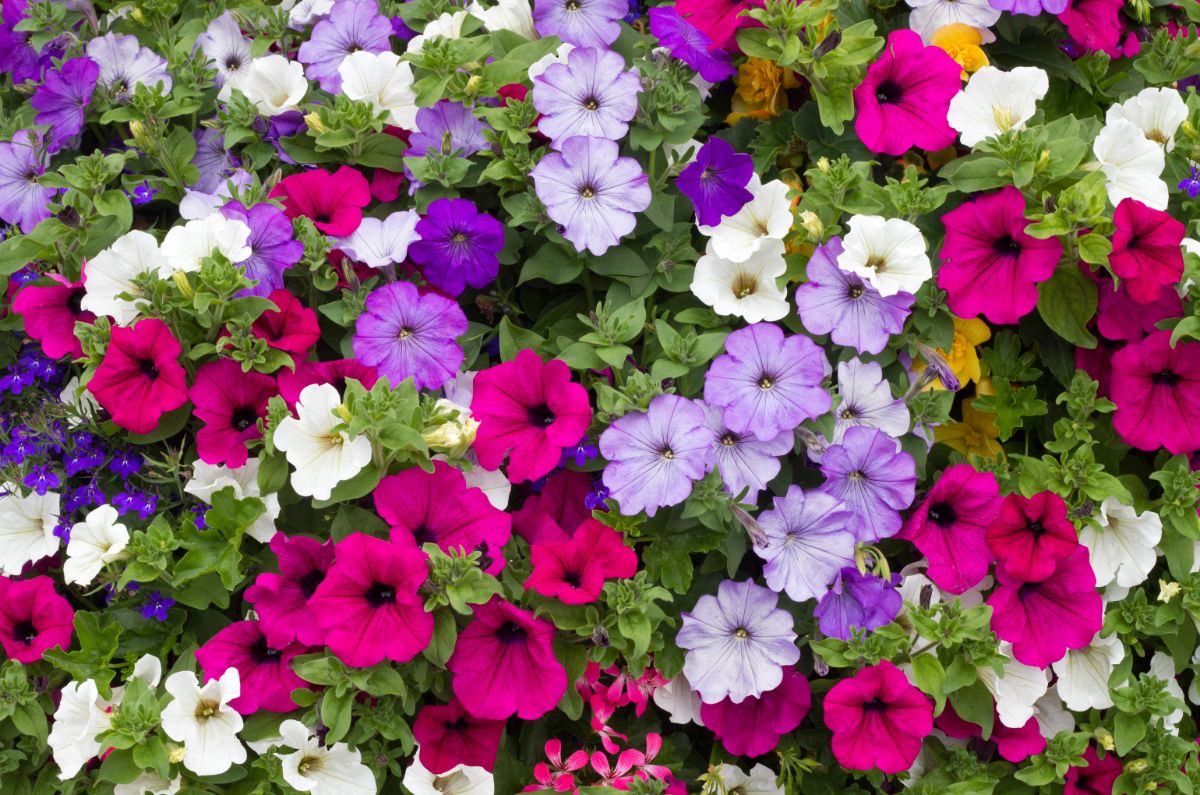
| Plant name: | Petunias |
| Annual or perennial? | Annual, in most areas |
| Growing zone: | Perennials in zones 9 to 11 |
| Watering requirements: | Moderate to high |
| Lighting: | Full sun to part shade |
One of the best plants for hanging baskets, petunias are long-season annuals, blooming from spring well into fall. But what makes these flowers truly spectacular is that they come in almost every color, with bi-color flowers being particularly popular.
Many petunia varieties are not frost tolerant; however, certain types, like ‘Wave,’ have been developed to handle slightly colder temperatures.
To prolong your fall growing time, try shielding your petunias with frost blankets or bringing them indoors on cold autumn nights.
26. Dianthus
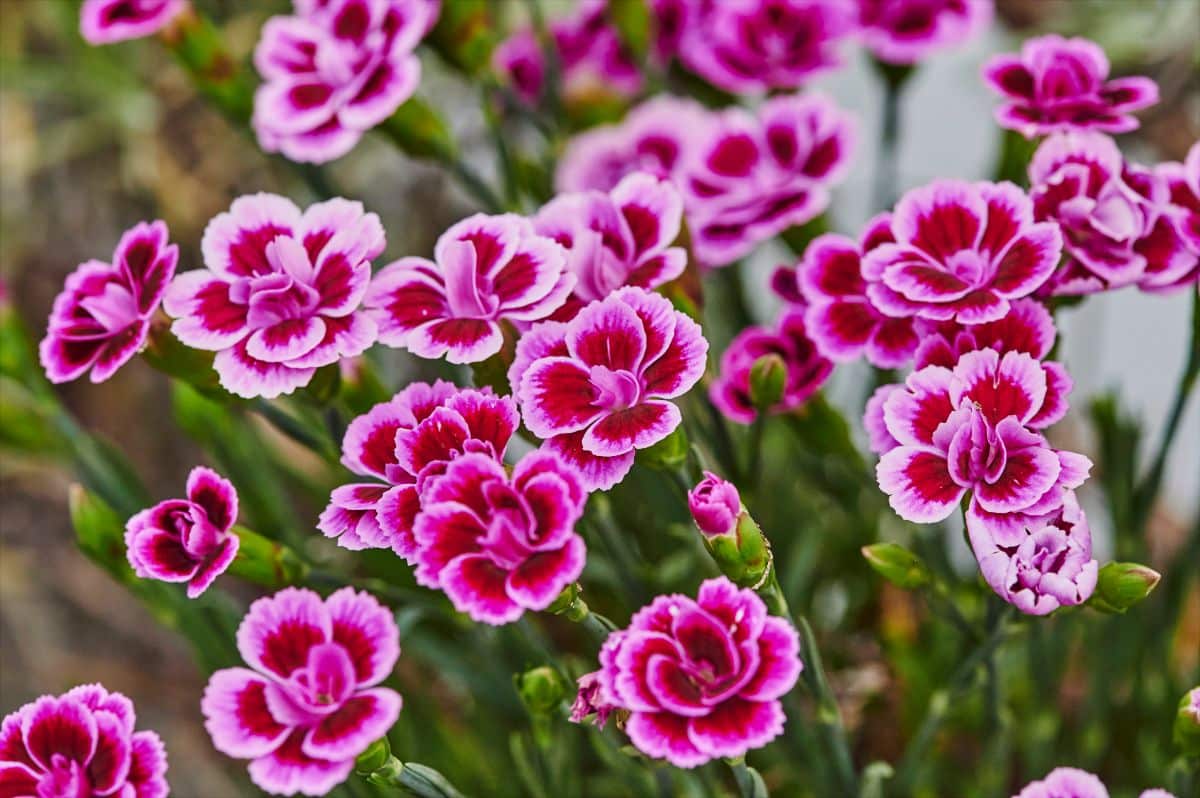
| Plant name: | Dianthus |
| Annual or perennial? | Annual |
| Growing zone: | Zones 3 to 9 |
| Watering requirements: | Moderate |
| Lighting: | Full sun |
Dianthus, also known as “pinks,” are closely related to carnations. With frilly flowers in pink and white, dianthus is a very feminine-looking plant that looks lovely in containers, cut flower beds and floral arrangements too.
As a genus, dianthus contains over 340 species of plants, coming from regions ranging from Europe to Asia and Africa. Growing up to 3’ tall, these low maintenance plants are great for beginners and can continue to bloom through light frosts.
27. Hardy fuchsia
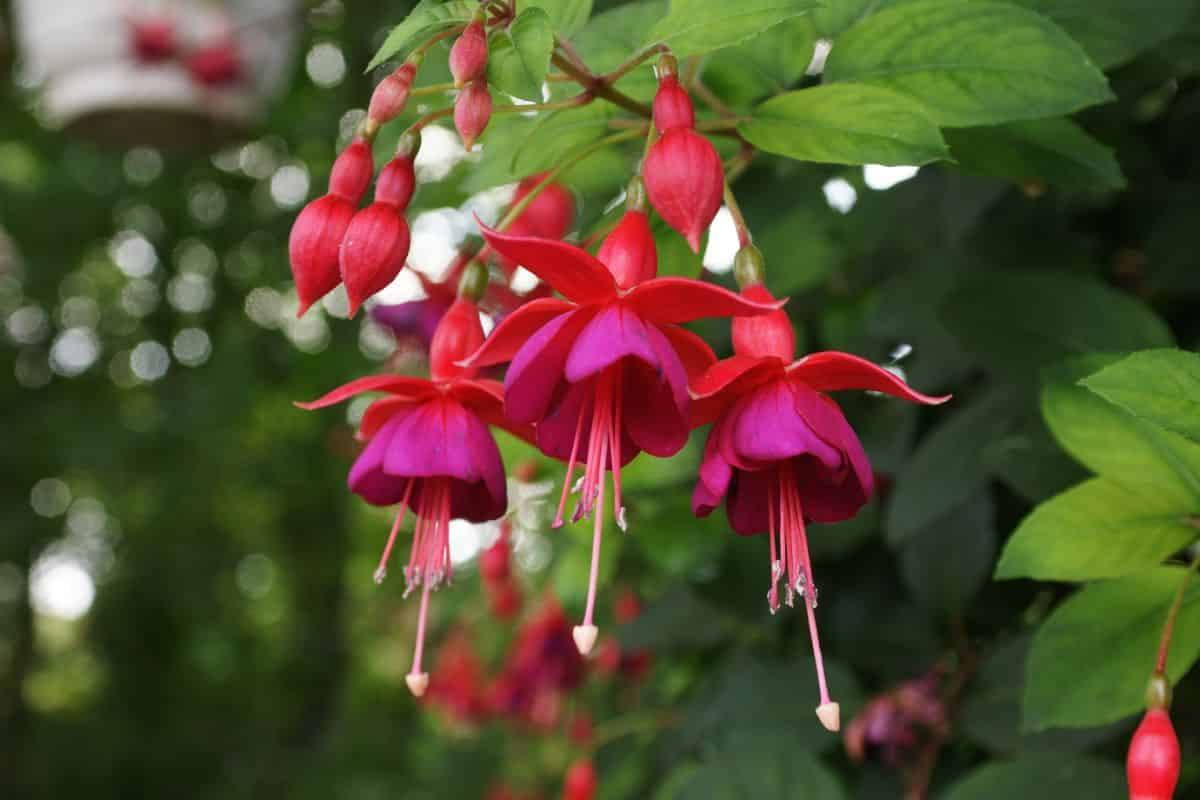
| Plant name: | Hardy fuchsia |
| Annual or perennial? | Annual, in most areas |
| Growing zone: | Perennials in zones 10 and 11 |
| Watering requirements: | High |
| Lighting: | Part shade |
Fuchsia’s bright purple and pink colors are certainly eye-catching and they lend a tropical feel to your space. Working well in containers, fuchsia really excels in hanging baskets that allow its trailing growth habit to be displayed in all its glory.
One of the best plants to keep for hummingbirds, fuchsia blooms spring through fall. They are also surprisingly hardy and can survive light frosts; however, they can benefit from a little extra protection on very cold nights.
28. Pansies

| Plant name: | Pansies |
| Annual or perennial? | Annuals, in most areas |
| Growing zone: | Perennials in zones 7 to 10 |
| Watering requirements: | Moderate to high |
| Lighting: | Full sun to part shade |
Pansies are some of the most popular plants for in-ground gardens and containers because they are just so resilient and versatile. They come in lots of colors and several different sizes too.
Pansies are also quite cold tolerant and are some of the first plants to bloom in spring and the last plants to flower in fall. However, they may die back a bit in summer if temperatures get very hot.
Pansies make lovely pressed flowers and are great for crafts. The flowers are also edible and make adorable salad toppers for creative chefs.
29. Nasturtium
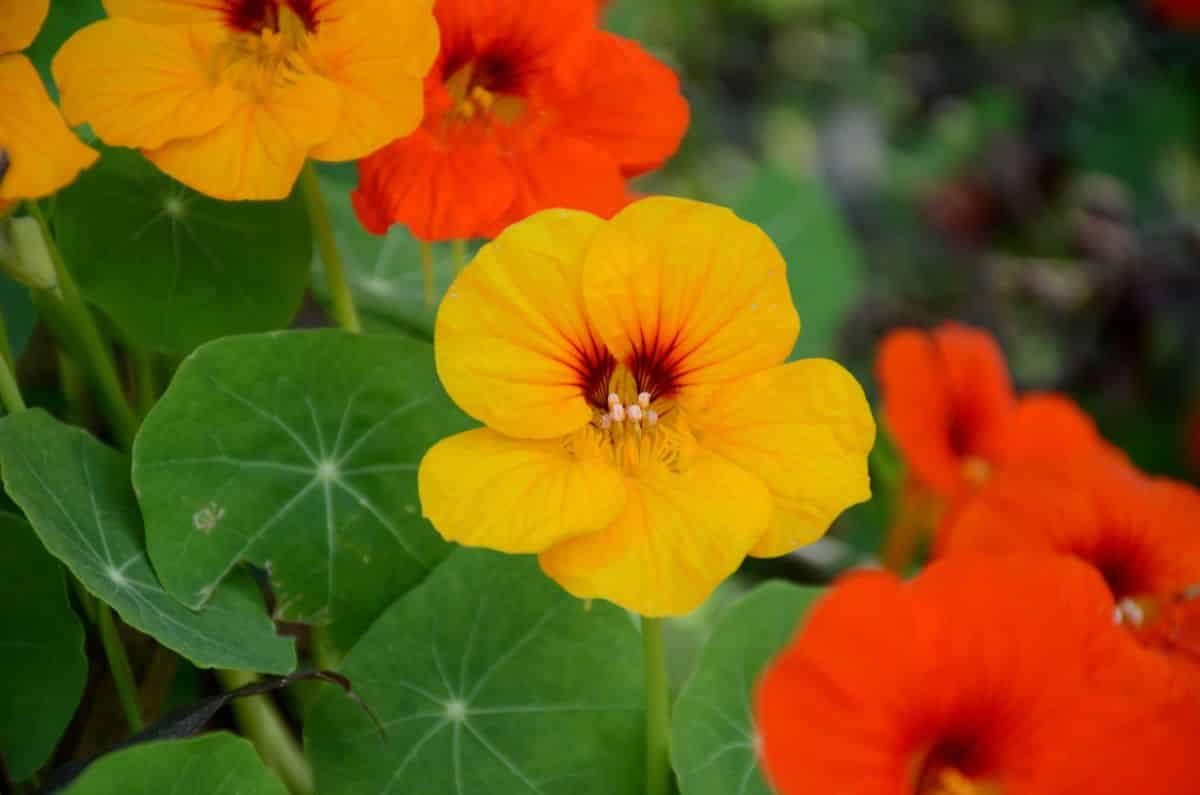
| Plant name: | Nasturtium |
| Annual or perennial? | Annuals, in most areas |
| Growing zone: | Perennials in zones 9 to 11 |
| Watering requirements: | Moderate |
| Lighting: | Full sun |
Nasturtiums’ yellow and orange flowers look like autumn, but they bloom in summer too. These plants are available in both mounding and trailing varieties; however, for container gardens, mounding types are usually best as they will grow more compactly.
Nasturtiums are naturally repellent to many garden pests, which makes them wonderful companion plants for more vulnerable species. They are also edible and lend a unique, peppery flavor to salads and other dishes.
For something different, try drying out your nasturtium leaves and flowers and powdering them into a uniquely flavored kitchen spice.
30. Bachelor buttons

| Plant name: | Bachelor buttons |
| Annual or perennial? | Annuals |
| Growing zone: | Zones 2 to 11 |
| Watering requirements: | Low |
| Lighting: | Full sun to part shade |
Bachelor buttons, also known as cornflowers, are happy little plants with undemanding needs. Drought-tolerant once established, bachelor buttons bloom from June through fall and will produce more flowers with frequent deadheading.
Most commonly sighted in blue, bachelor buttons also come in white, pink and purple. Flowers are also edible and are often used as salad toppers or creative garnishes for desserts.
The importance of autumn blooms
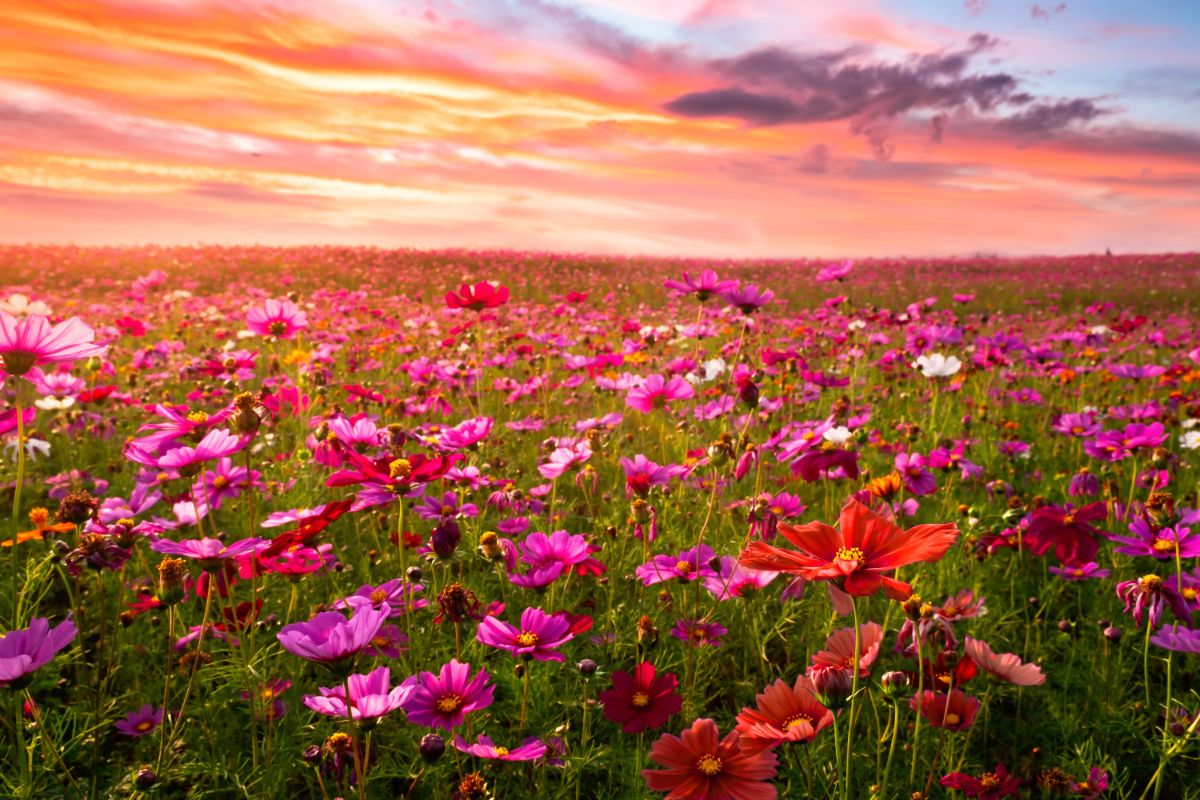
Gardens are sources of delight and enjoyment for many, so when flowers start to fade and plants begin to die back at the end of summer, it can be a bit sad. These natural signs hint at the cold winter months ahead and many gardeners seek ways to extend their growing season.
Late-blooming and long-blooming flowers are a good way to hold off the winter blues for quite a while. Autumn flowers can bloom well into fall, some lasting through multiple frosts and light freezes.
Additionally, after the heat of summer, many gardens can look a bit faded. Flowers may be withering and plants may not look their best due to pest damage and common diseases like powdery mildew. Newly emerging autumn flowers can be a very welcome sight and a much-needed pick-me-up for tired garden beds and planters.
But there are more benefits to planting fall-blooming flowers than simply aesthetics. Fall gardens can provide lots of food and valuable resources for pollinators, beneficial insects, hibernating chipmunks and migrating birds.
Late-blooming flowers can be the last bit of nectar and pollen that honeybees and other pollinators can find. That means that autumn-blooming plants can play an essential role in pollinator survival and are a critical feature in pollinator gardens.
Additionally, seed-producing plants, such as amaranth and sunflowers, are a prime food source for chipmunks, squirrels and songbirds. Full of fat and vitamins, these seeds can help hibernating critters and migrating birds store up the nutrients they need to last through the long winter months ahead.
Whether you are looking for more color in your garden, you want to enliven your flower beds or you’d like to help out pollinators, there are so many reasons to try out some fall-blooming plants. So, let’s explore some of perfect plants for your autumn garden to help you decide which plants will work best for you and your backyard space.
Conclusion
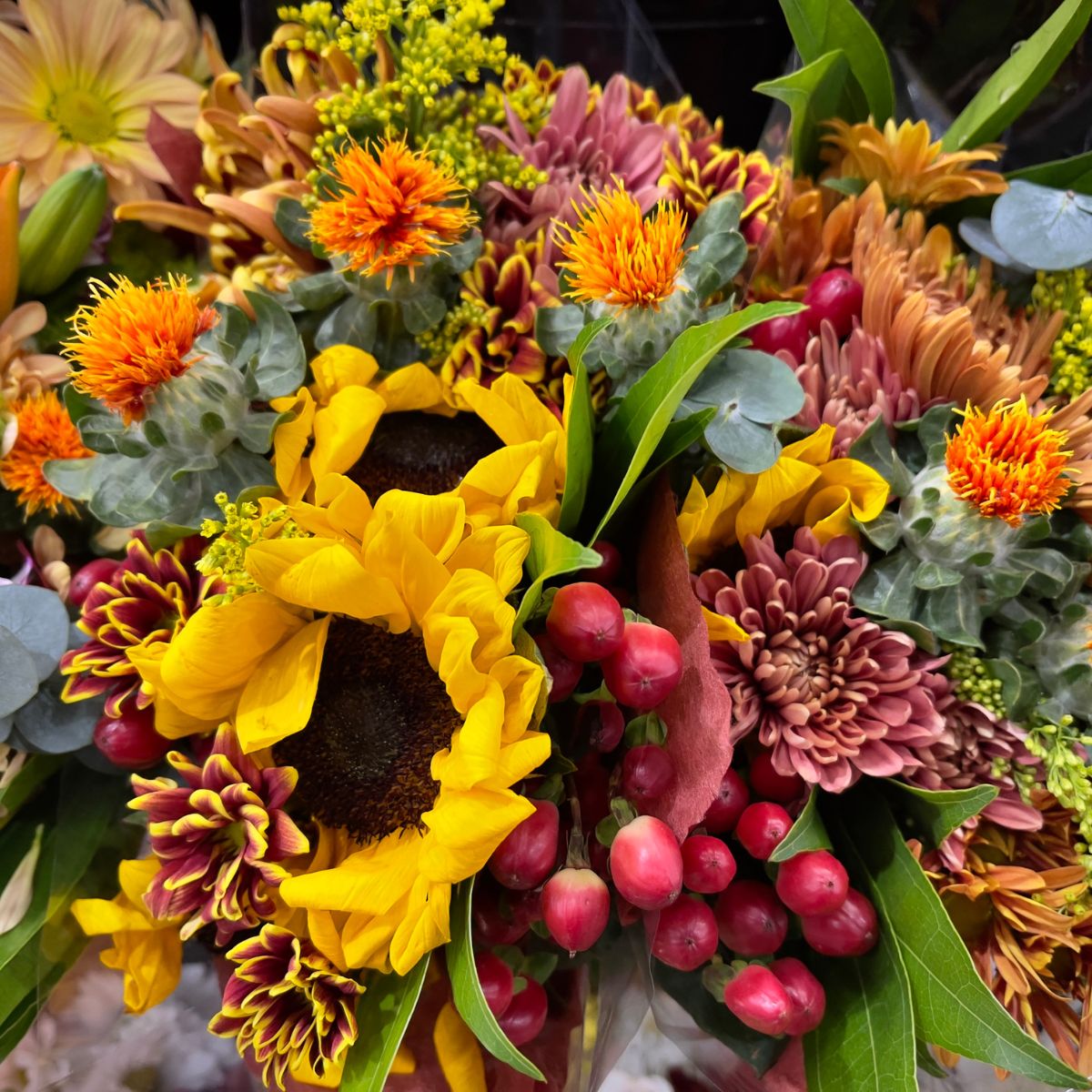
Even though spring and summer may get all of the attention for being the “best time for flowers,” that simply isn’t the case. There are a remarkable amount of plants that will happily bloom well into autumn under the right conditions.
These plants include both annuals and perennials, hanging specimens and flowers that work for crafts and in cut flower beds. This wide variety of late-blooming plants means that, no matter your gardening interest, there are plenty of plants to try in your fall garden.
But beyond season extension and the sheer beauty of fall bloomers, there are some very real and tangible benefits of planting autumn flowers too. These plants will provide an important food source for visiting pollinating and migrating birds and can make all the difference for these animals’ survival during the winter.
So, this year, as you are finishing up your garden planning, think about the full picture. Plan for spring plantings and summer blooms, but also consider what plants to sow for your autumn garden. Just because temperatures are cooling off, doesn’t mean that you can’t have bright beds full of flowers all through the autumn season.

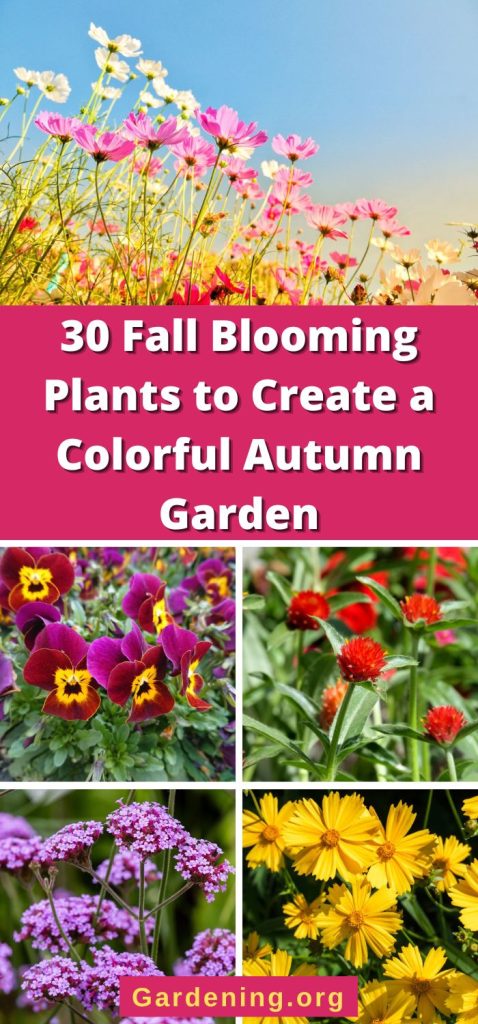
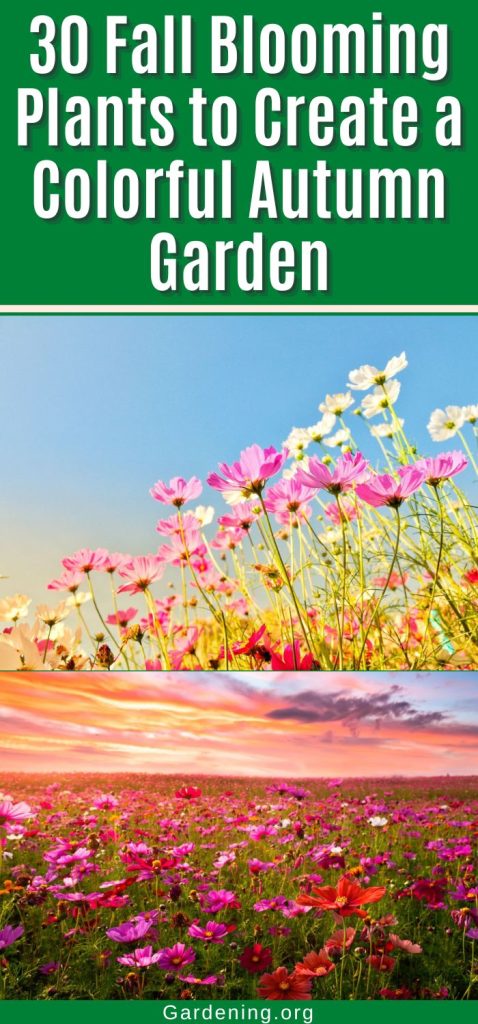
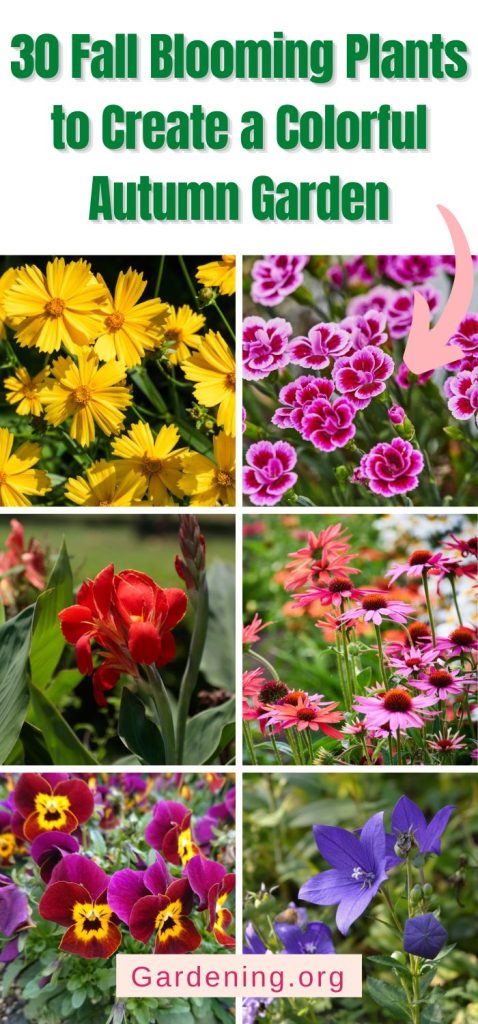
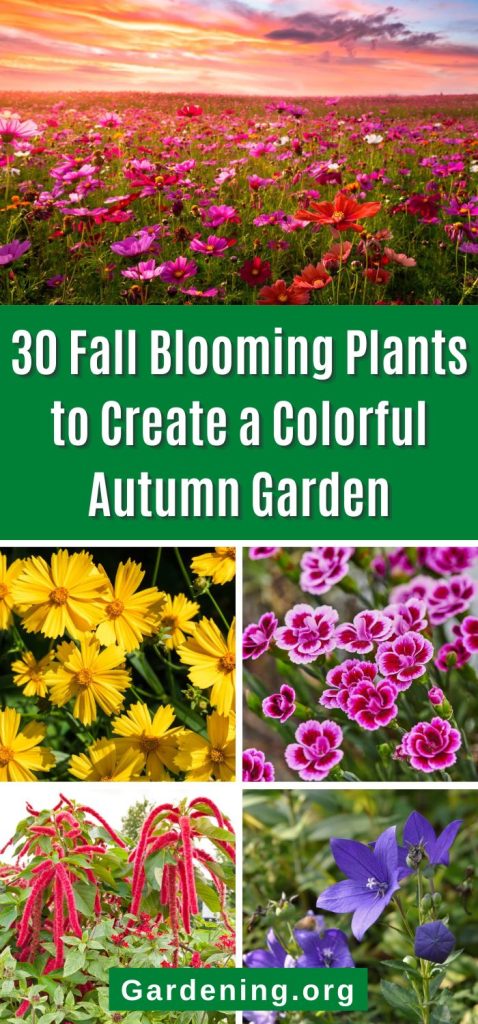
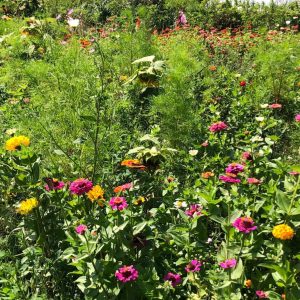
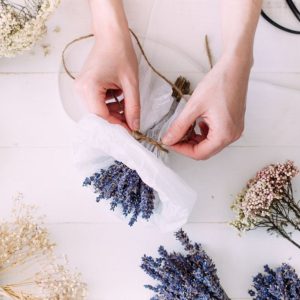
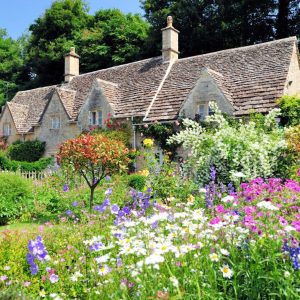
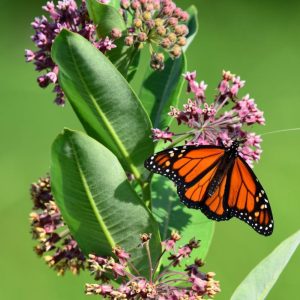
Leave a Reply